Travel Guide to Kotor, Montenegro – Historical City with Amazing Views
Kotor is the most popular city in Montenegro among tourists from multiple countries. Everyone comes here. Including on large cruise ships. Even though Kotor is a small town. Its population is only 13000 people. In this ultimate Kotor City Guide I’ll tell you how to explore this amazing place best. So, what is Kotor, Montenegro famous for?
Kotor is a well-preserved Old Town with a rich history. It’s located in a picturesque place in the Bay of Kotor, at the foot of Mount Lovcen. Even more stunning views are from the fortress above the city and the mountain serpentine leading to the Lovcen National Park. Many images and videos for Montenegro advertising brochures are made there.
Unlike other tourist destinations in Montenegro, Kotor is as multinational as possible. Overall, a very limited number of foreign languages can be heard across the country. Since many tourists from a small number of countries traditionally go to Montenegro. German, French and even “native” English languages are rare in this country. But everything is different in Kotor. All the diversity of the peoples of Europe, and not only, instantly pours onto the shore even from a single cruise liner.
Hence, one significant plus of Kotor compared with the rest of Montenegro is that many locals speak English well.
But let’s get down to my Kotor City Guide.
Where is Kotor?
So, you already know that the city of Kotor is located in the country of Montenegro. And it’s essential info to start. Because many tourists still keep printing queries like “where is Kotor Montenegro” into the search box. People have just heard something about a popular place they would like to visit. But they don’t even know where it is :) Many believe Montenegro is somewhere in Croatia, a neighbor of Montenegro, and a much more popular country worldwide.
Kotor is located in the northern part of the Montenegrin coast. In the community of the same name – Kotor. On the shore of one of the most beautiful places in Montenegro – the Bay of Kotor, which is also known as the southernmost fjord in Europe.
To get from the Adriatic Sea to Kotor, you need to sail about 30 km on a boat. Passing several picturesque straits and historic towns on the bay coast, surrounded by mountains descending to the water. On this way, you will see almost all the most amazing places of Boka Kotorska (yes – this bay has many names).
History
Illyrians inhabited the territory of modern Kotor in ancient times. In fact, the history of many peoples and settlements in this part of the Adriatic Sea is generally conducted from these guys.
The foot of a Roman soldier stepped on these lands approximately in the III century BC. In 476, the barbarians got tired of mocking the last Roman emperors, appointing and dismissing them at will. And they finally abolished the Western Roman Empire. The settlement on the lands of the modern Kotor came under the rule of Byzantium. In those days, they started to mention the name “Kotor.” The city became the center of the entire bay and gave it its name – Boka Kotorska (“Boka” translates as “bay”).
In 535, the Byzantine emperor Justinian built a fortress over the city. In the 10th century, a “lower” city grew under it. That’s how the prototype of the modern Kotor appeared.
Byzantine rule was interrupted several times by the Bulgarians and Serbs. Then the threat hung over the Byzantine Empire itself. In 1453, Constantinople fell under the onslaught of the Ottoman Turks. In Kotor, they did not wait for this unfortunate hour. And already in 1420, the Great City Council decided to come under the control of the Venetian Republic. They lived hand in hand until 1797 when the Most Serene Republic of Venice ceased to exist through the guilt of Napoleon.
The Venetian period left the most profound mark on the history of Kotor and its appearance. At this time, the city also got the Italian version of the name – Cattaro. Even now you may meet it, for example, in the names of hotels and restaurants. Probably it helps to attract tourists from Italy. And yes, it does sound more glamorous.
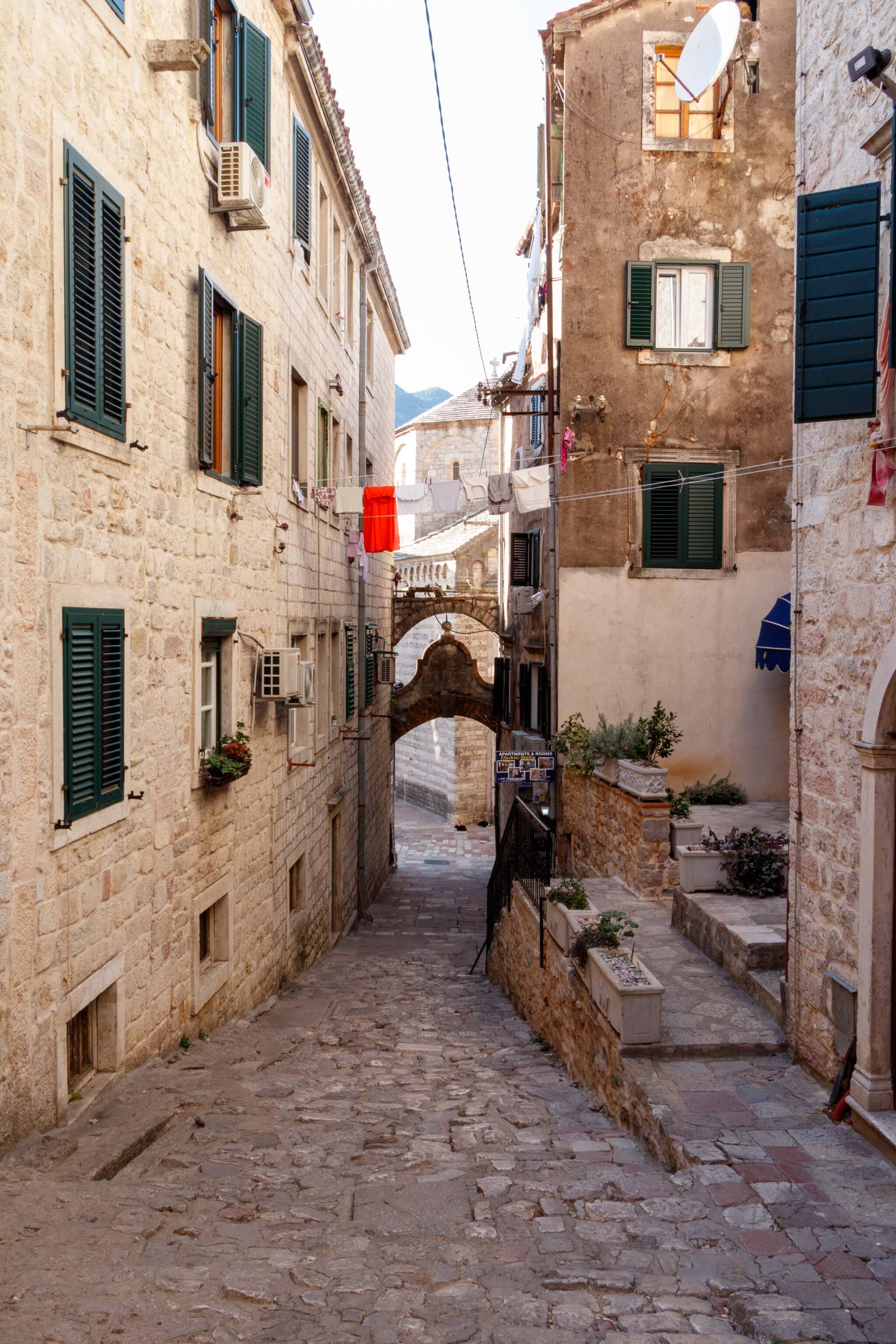
For centuries, Kotor bordered the lands of the Ottoman Empire, which regularly tried to conquer it. But the Turks failed in doing this. Despite the fact that even the more northern cities of the Bay of Kotor (for example, Herceg Novi) were conquered.
Until 1814, Kotor managed to be ruled by the French, Italians and Austrians. The Russians forced the latter out for a short period. The Russians were driven out again by the French. In 1814-1918 Kotor was under the rule of the Austrians.
The First World War ended for the city with the entry into the newly created kingdom of Serbs, Croats and Slovenes. According to the results of World War II, Kotor, as part of the Republic of Montenegro, became part of Yugoslavia. Since 2006 – it’s been the city of independent Montenegro.
Things to Do in Kotor
The list of things to see in Kotor, Montenegro, will not be long. The main attraction is the city itself as a whole. You can find all the best places in Kotor on the paper city map. You can get it for free at the tourist kiosk in front of the main entrance to the city through the Sea Gate. Or take a photo of the map on the wall at the entrance to Kotor.
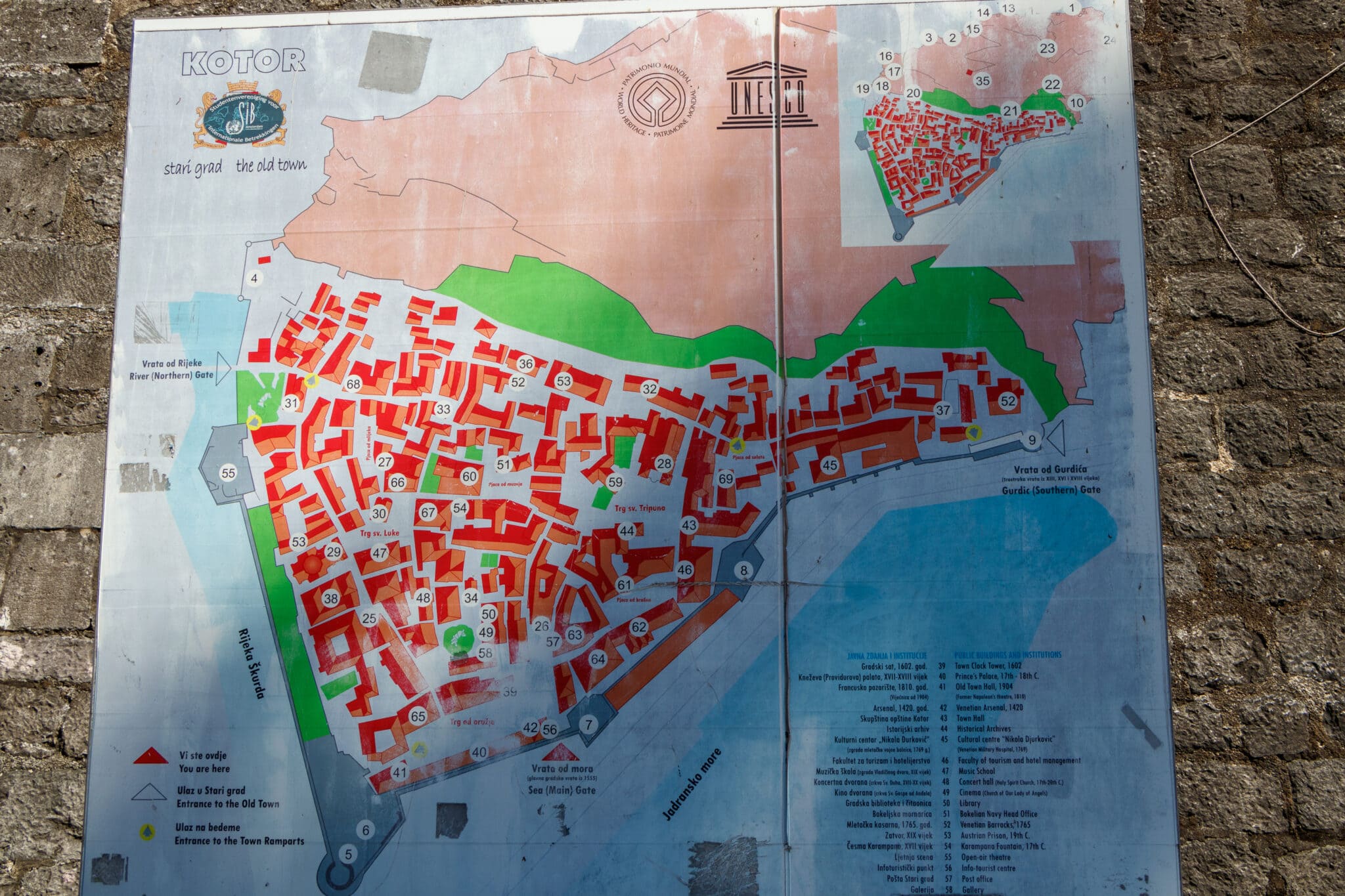
What to see in Kotor Old Town?
Kotor Old Town is the largest surviving old town in Montenegro. And it was well preserved precisely as a whole town, not separate historic buildings. The massive city walls also survived. Already at the entrance it is getting clear that something impressive has appeared before you.
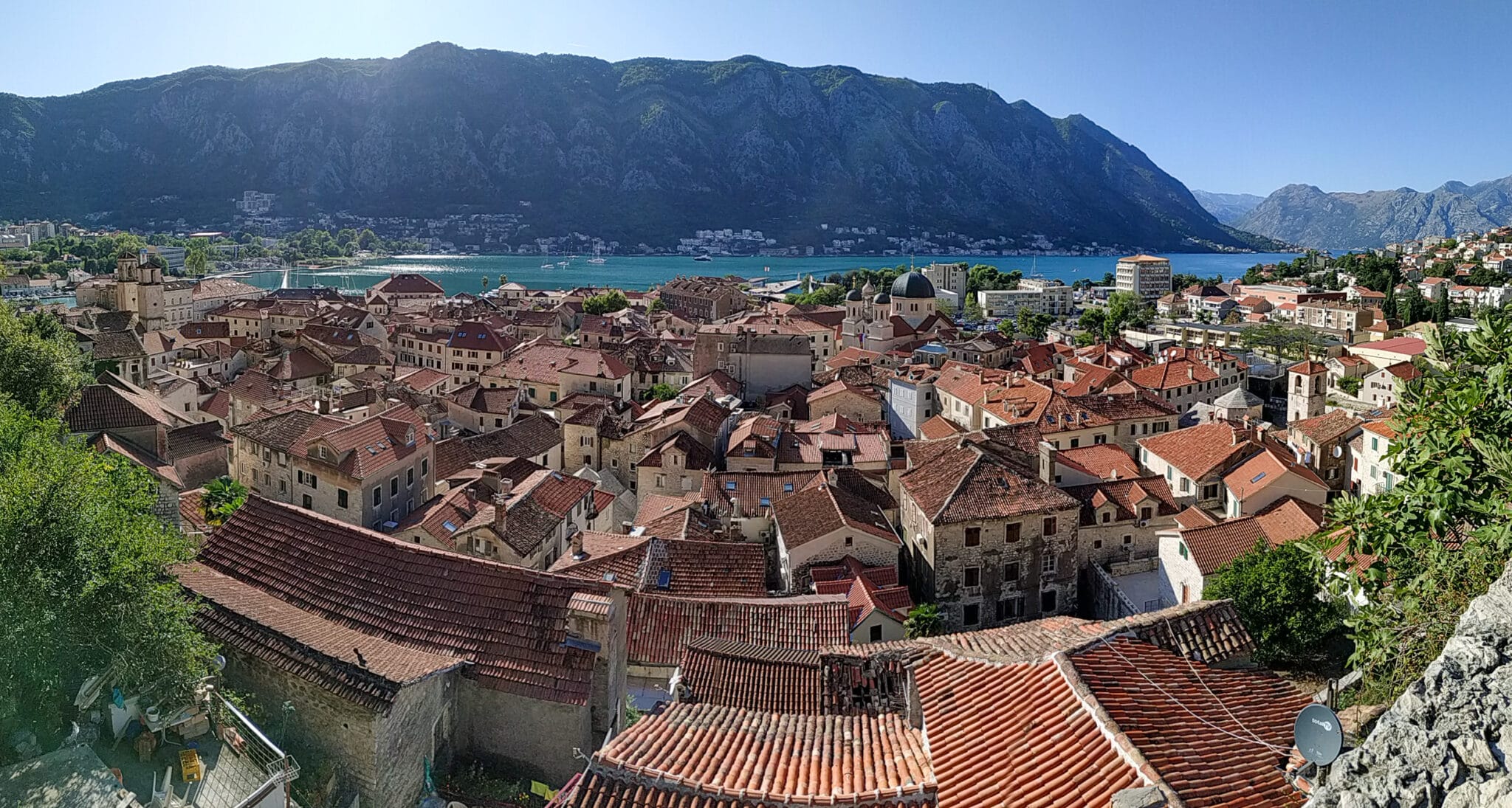
Kotor Old Town was severely damaged by the 1979 earthquake. After that, it was included in the UNESCO World Heritage List.
Architecturally and culturally, there are traces of the presence of Rome, Byzantium, Venice and Austria in Kotor. But primarily – the Venetian Republic. The Ottoman Empire failed to conquer Kotor, despite numerous attempts. So don’t expect to see mosques or minarets here.
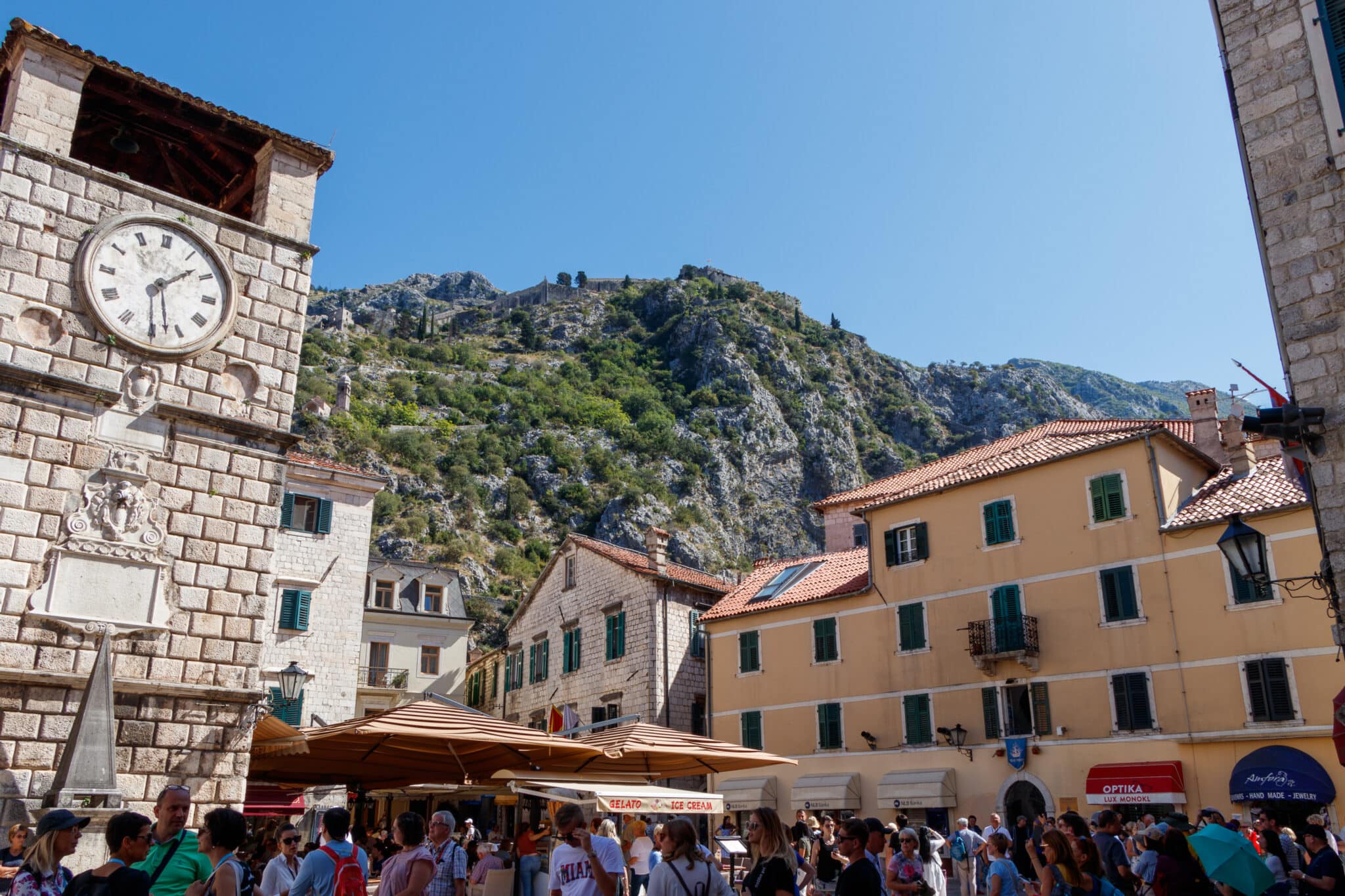
But let’s get down to the list of what you must see on your holidays in Kotor, Montenegro.
Kotor City walls
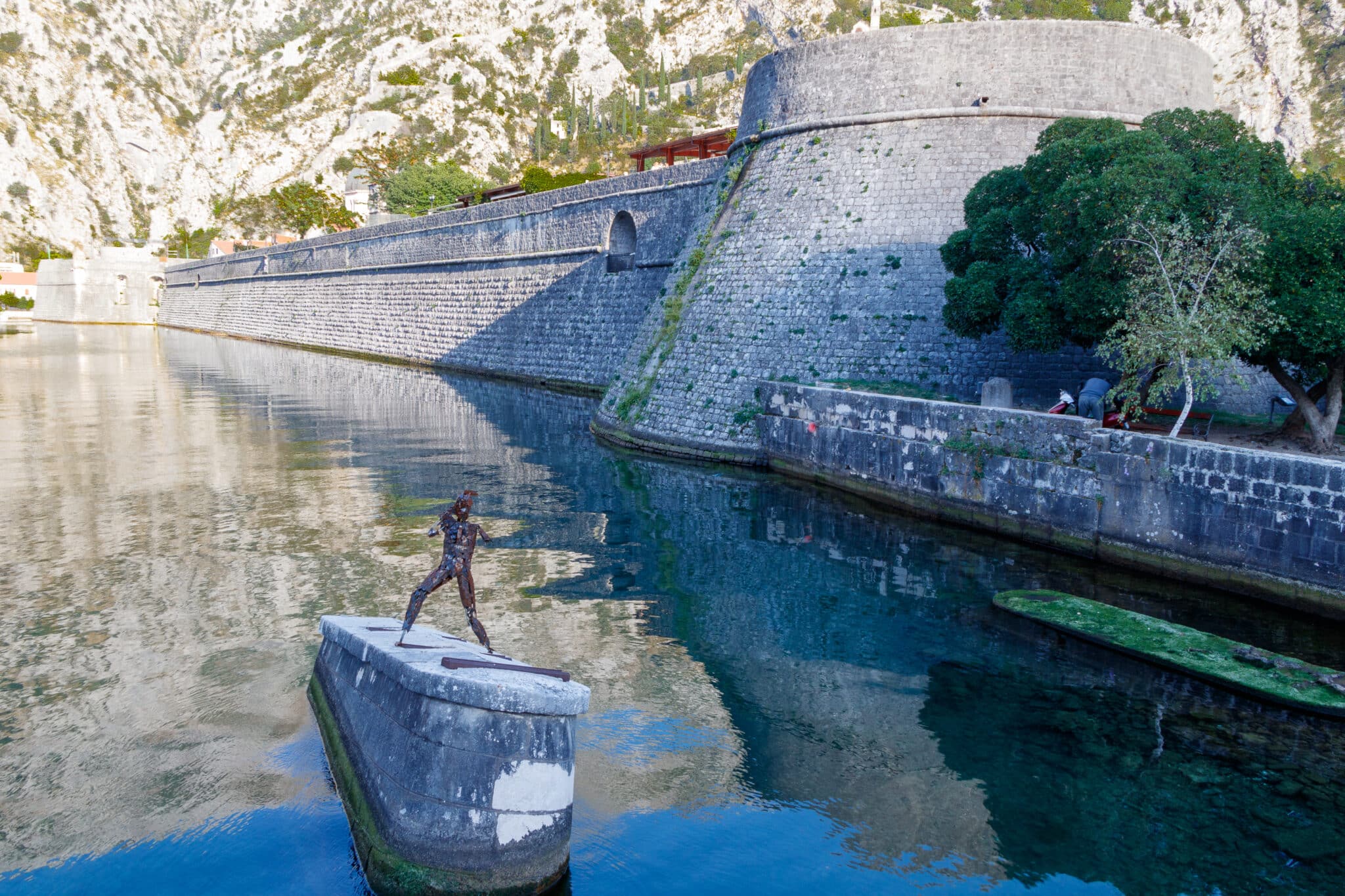
Kotor city walls were built and rebuilt for almost ten centuries. But the main essence of this fortification was laid at the very beginning. The fortress walls were supposed to encircle the “lower” city and the fortress above it. This solution proved to be the best for many centuries. And it has survived to this day.
The total length of the Kotor city walls is 4.5 km. The declared height is up to 20 m, the thickness is up to 16 m. And all this goes to a height of 260 m, to the fortress of St. John (San Giovanni). You can walk along the fortress walls encircling Kotor, having examined it a little from above and close.
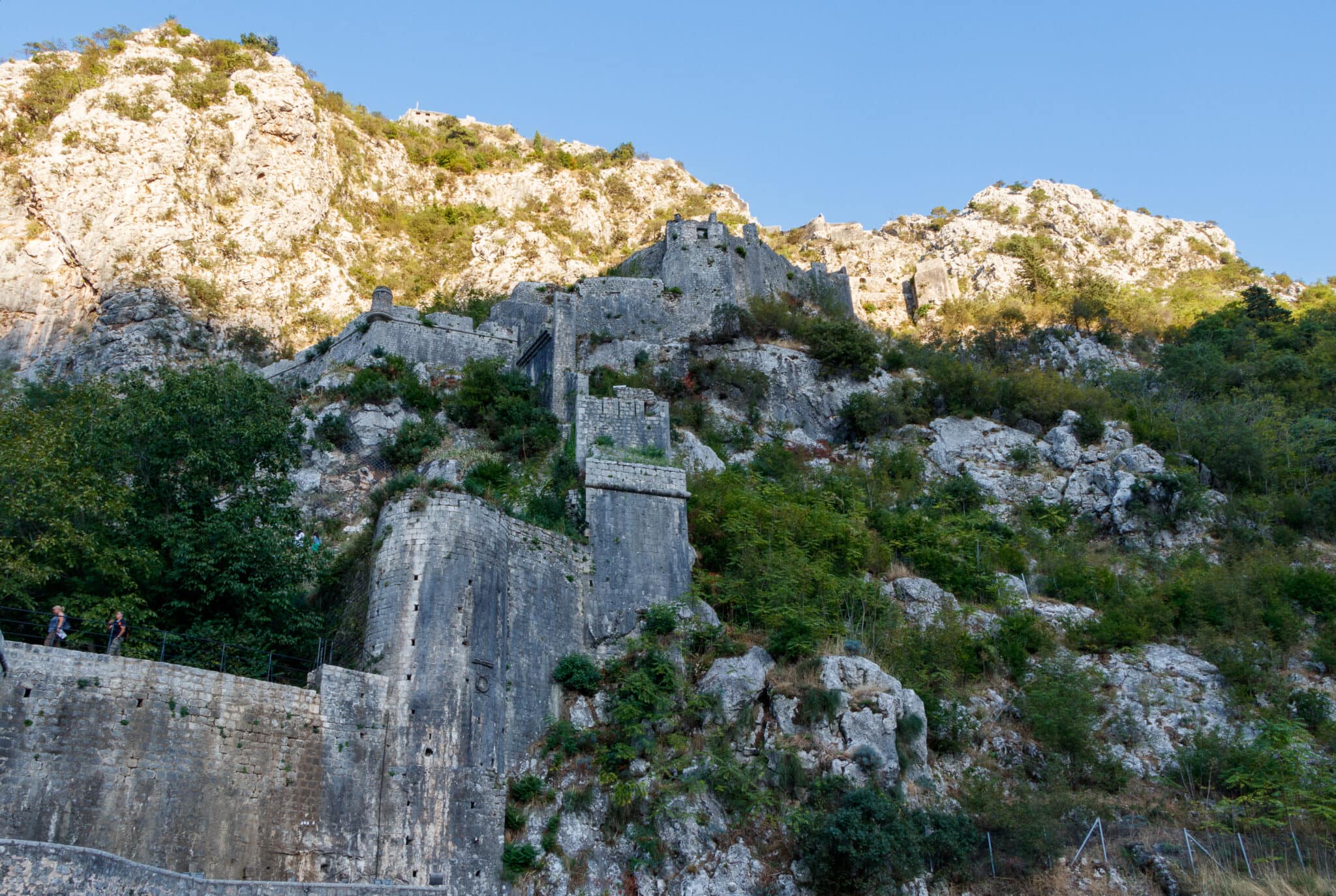
City Gates
There are three city gates in the Kotor Old Town.
Sea Gate
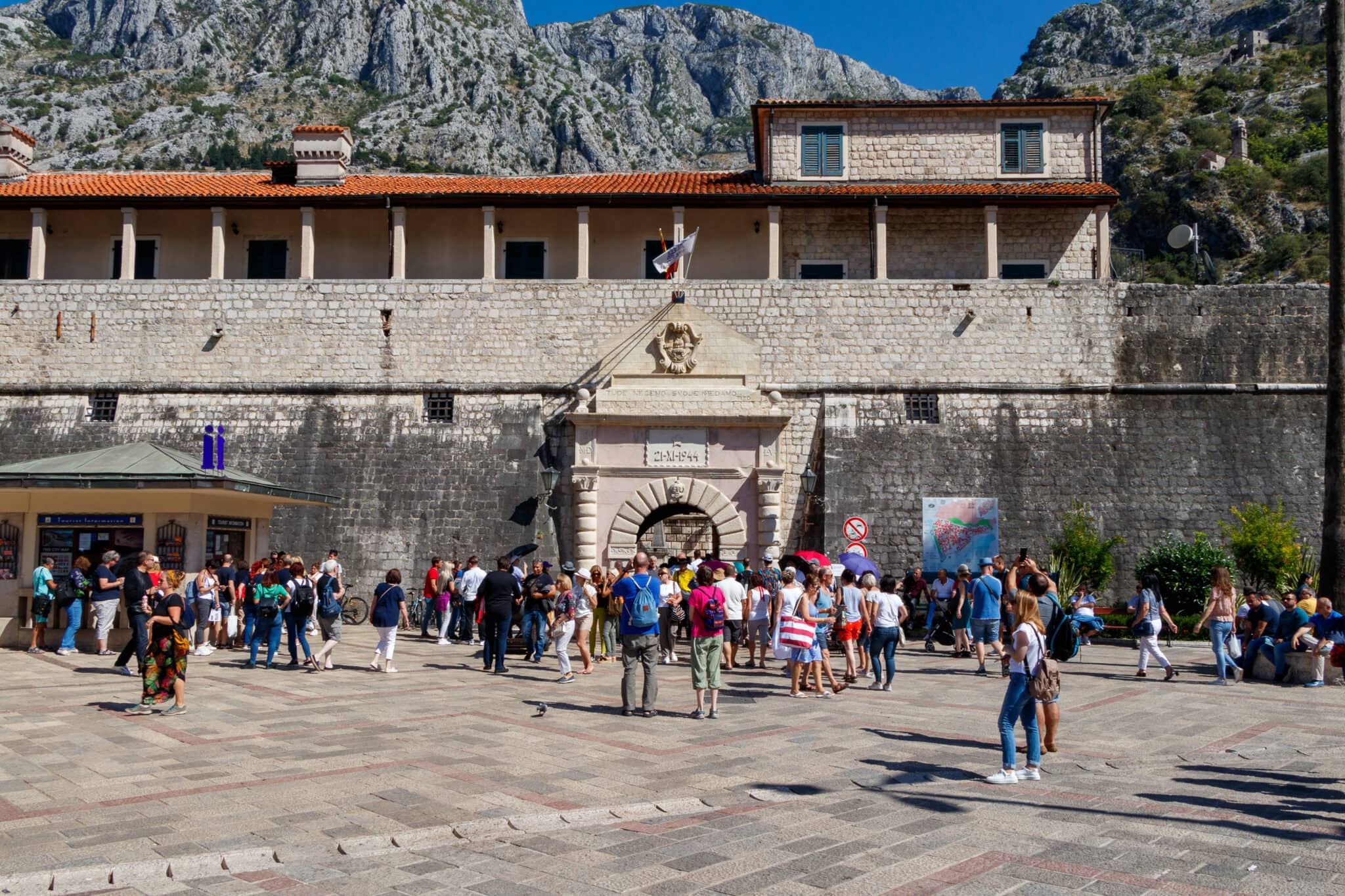
The Sea Gate of Kotor is the main entrance to the Kotor Old Town. It’s located right in front of the port. Very close to the 300-meter pier, where huge cruise ships moor. It was built in the 16th century. Here, you realize that you are in a place steeped in rich, centuries-old history.
South Gate (Gurdic Gate)
South Gate or Gurdic Gate in Kotor is a small gate on the “right” side of Kotor.
North Gate (River gate)
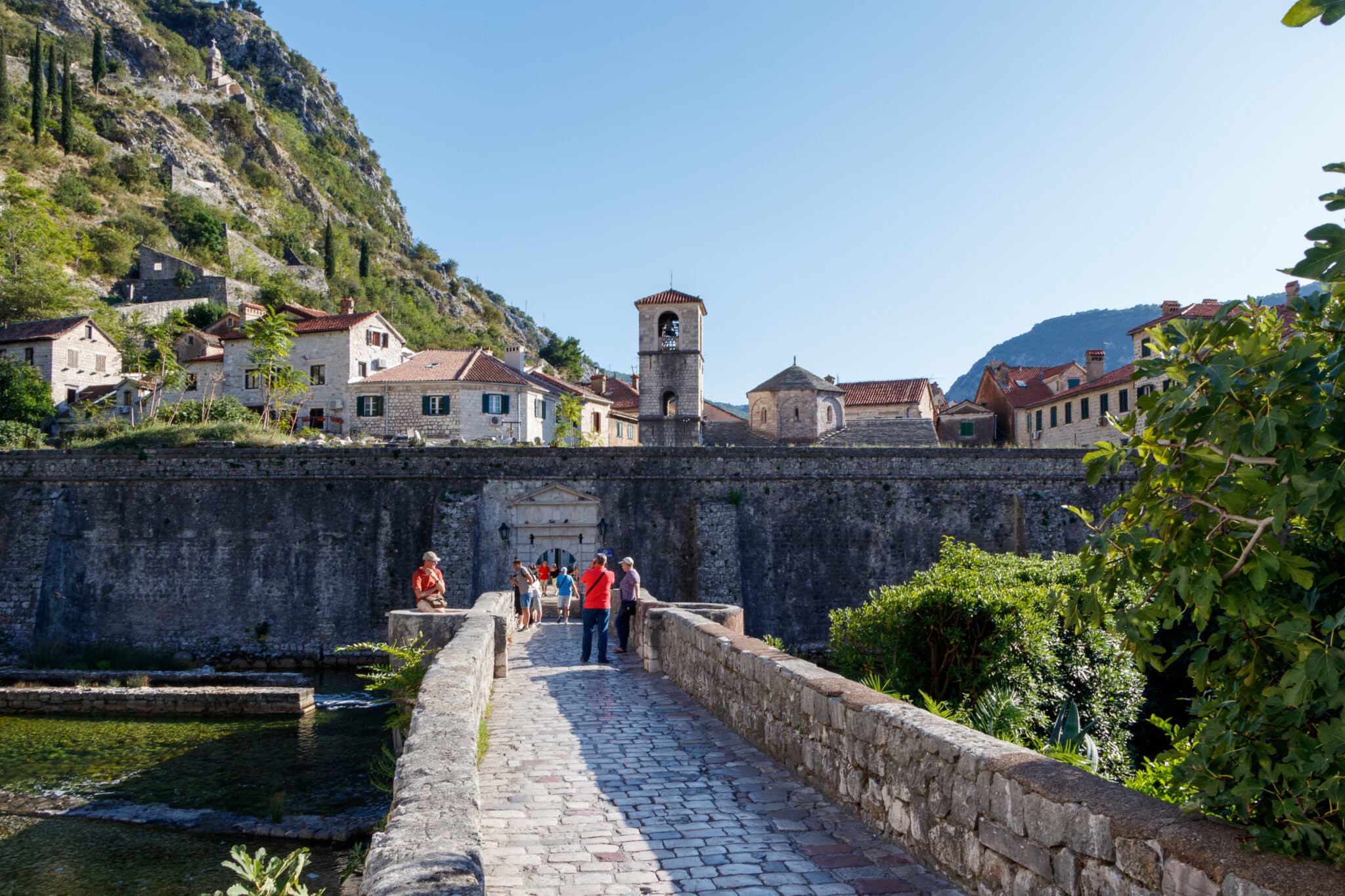
Kotor’s North Gate or River gate was built in 1539. It’s also small. The reason for its construction was the reflection of one of the most dangerous sieges of the city by the Turks. Then Kotor was attacked by a 30,000-strong Ottoman army led by the legendary pirate admiral Hayreddin Barbarossa.
River Gate is located on the “left” side of Kotor. Not far from them, the ascent to the fortress above the city begins along the old “Austrian” road.
Cathedral and churches
Among the historical religious buildings in Kotor, which may be attractive to tourists, the following should be noted:
St. Tryphon Cathedral
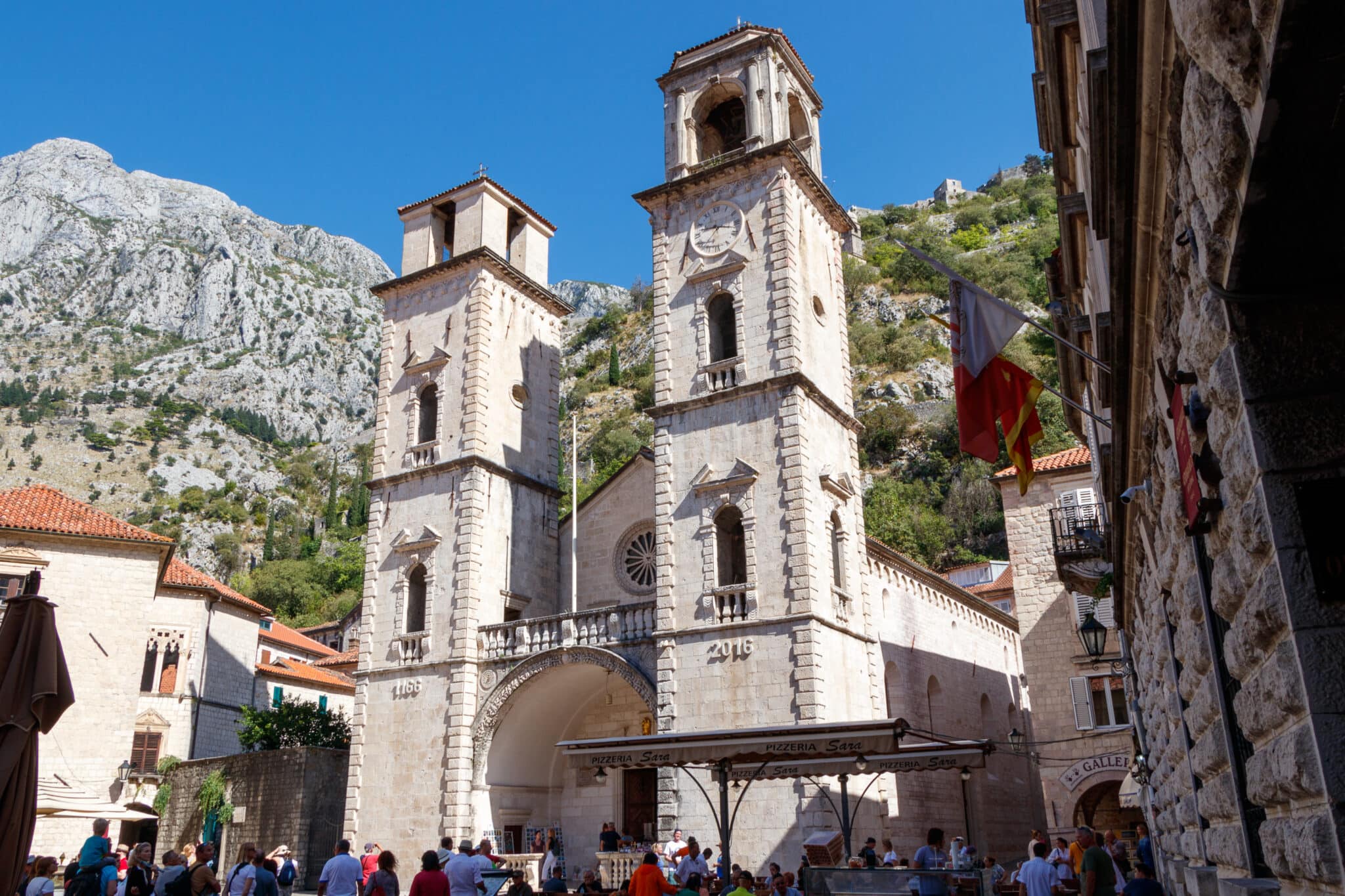
St. Tryphon Cathedral in Kotor Old Town was built in 1166. Twice it was severely damaged by earthquakes and was rebuilt. The last time – at the initiative of UNESCO, after the earthquake in 1979.
Church of St. Luke
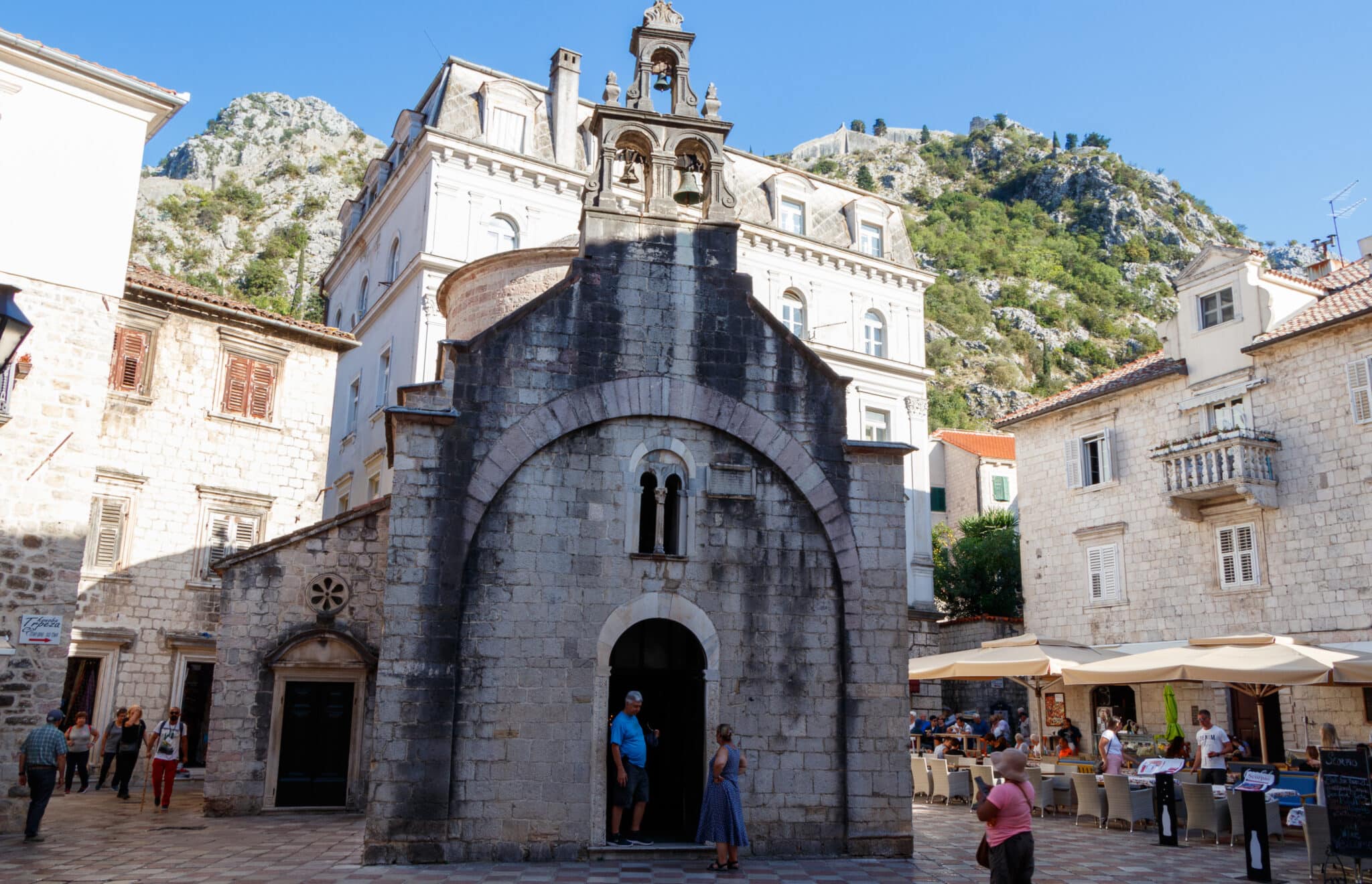
St. Luke’s Church in Kotor Old Town was built in 1195. And it’s a pretty unique one. St. Luke’s church was originally Catholic. But since 1657 it has two altars – separately for Catholic and Orthodox rites. They must thank Turks for such an unusual mixture. As a result of their another invasion, many Orthodox people found refuge in Kotor. And the local Venetian CEO allowed the church of St. Luke to be used for Orthodox rites.
It’s unknown whether there were Protestants in Kotor and whether they felt discrimination about this. But the third altar in the church of St. Luke never appeared.
St. Nicholas Church
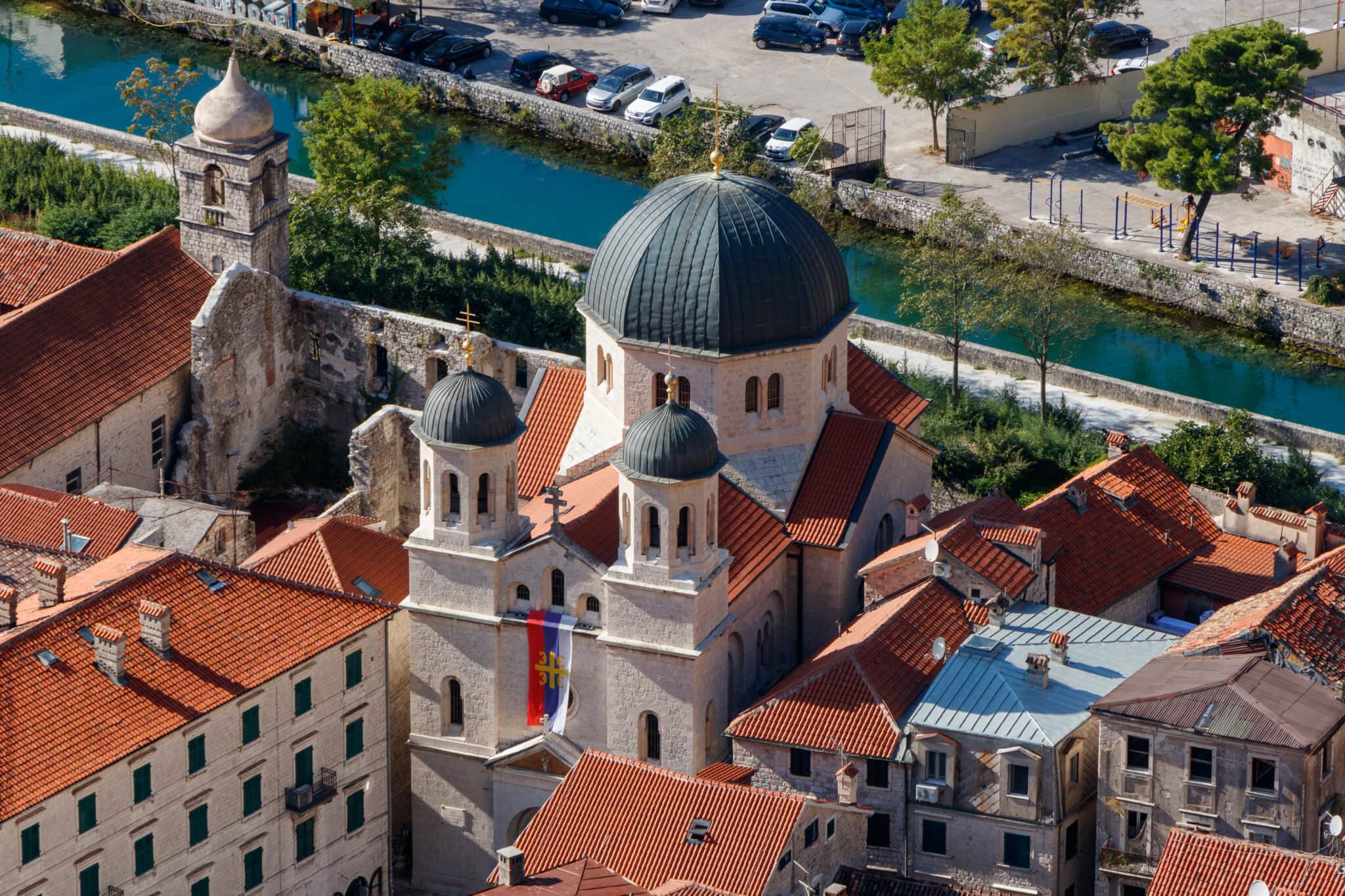
The Church of St. Nicholas was built recently, according to the standards of Kotor – in 1810, during the Napoleonic rule. In 1896 it burned down. In 1909 it was restored in the Byzantine style. Today it is one of the most visible buildings in Kotor from the mountain above the city.
St. John’s Kotor Fortress
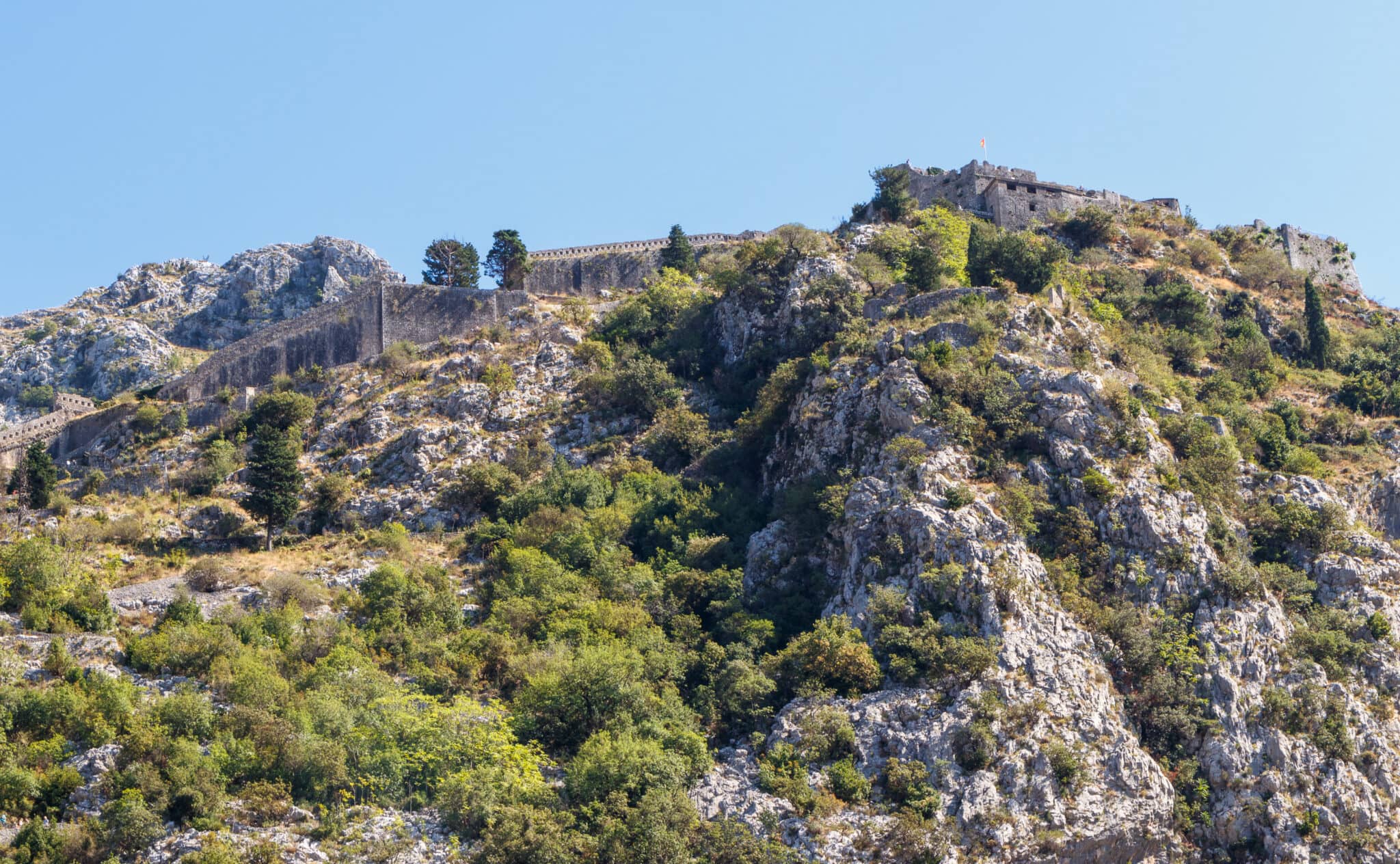
St. John’s Fortress is a unique fortification – a must-see attraction in Kotor. The fortress itself and the long fortress walls are skillfully “built” into the mountain above Kotor. They merge so organically with the landscape that not everyone notices them the first time. Massive walls encircle both the fortress and the Old Town, located under the mountain.
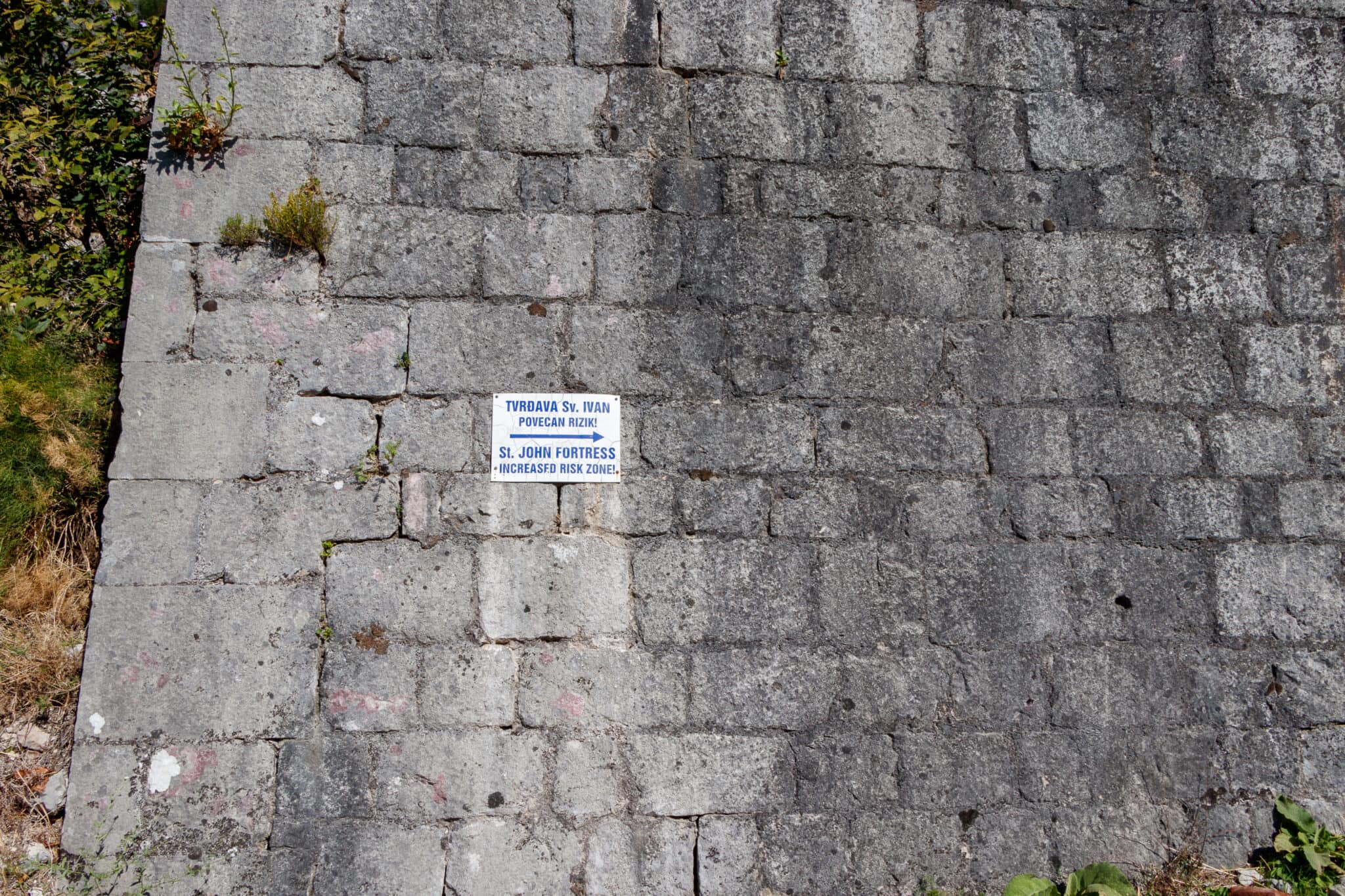
Climbing up the stone ladder to the fortress (paid)
The hike to the St. John fortress in Kotor is already a remarkable adventure in itself. It is located at an altitude of 260 m. Climbing along the primary way, a thoroughly destroyed stone ladder, is long and steep. In Montenegro, it’s not exceptionally customary to ennoble something that already generates income. By the way, the Kotor fortress entrance fee is €8 (maybe today it’s even more expensive).
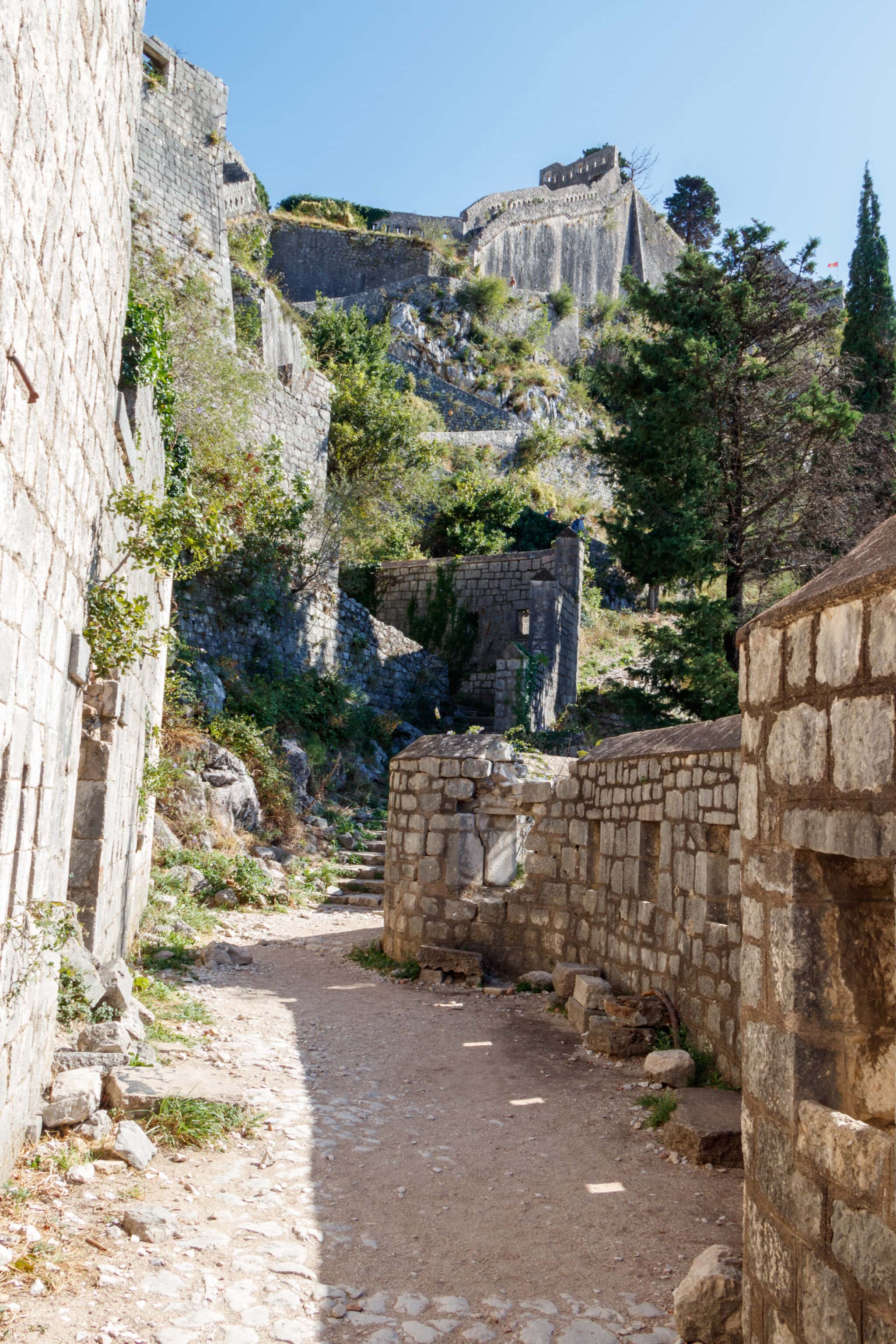
There are two exits to the ladder of Kotor trailhead leading to the fortress – “left” and “right”. You can easily find them both on Google Maps or Maps.me, and on a paper map of Kotor, which you can get for free at the tourist kiosk in front of the city entrance.
There is a ticket booth near both entrances. They have a terminal for paying by card (for Montenegro – it’s just incredible). There is no fundamental difference from where to start the ladder of Kotor hike. Whichever exit you are closer to, start from there.
The ladder of Kotor hike time is approximately 1 hour if you are not in a hurry. I got to the Kotor fortress in 50 minutes, with a few short breaks to shoot some photos and videos. Well, not just to film a bit of Kotor, but also to take a breath, because I was in a hurry. And the day was very hot, despite the middle of September.
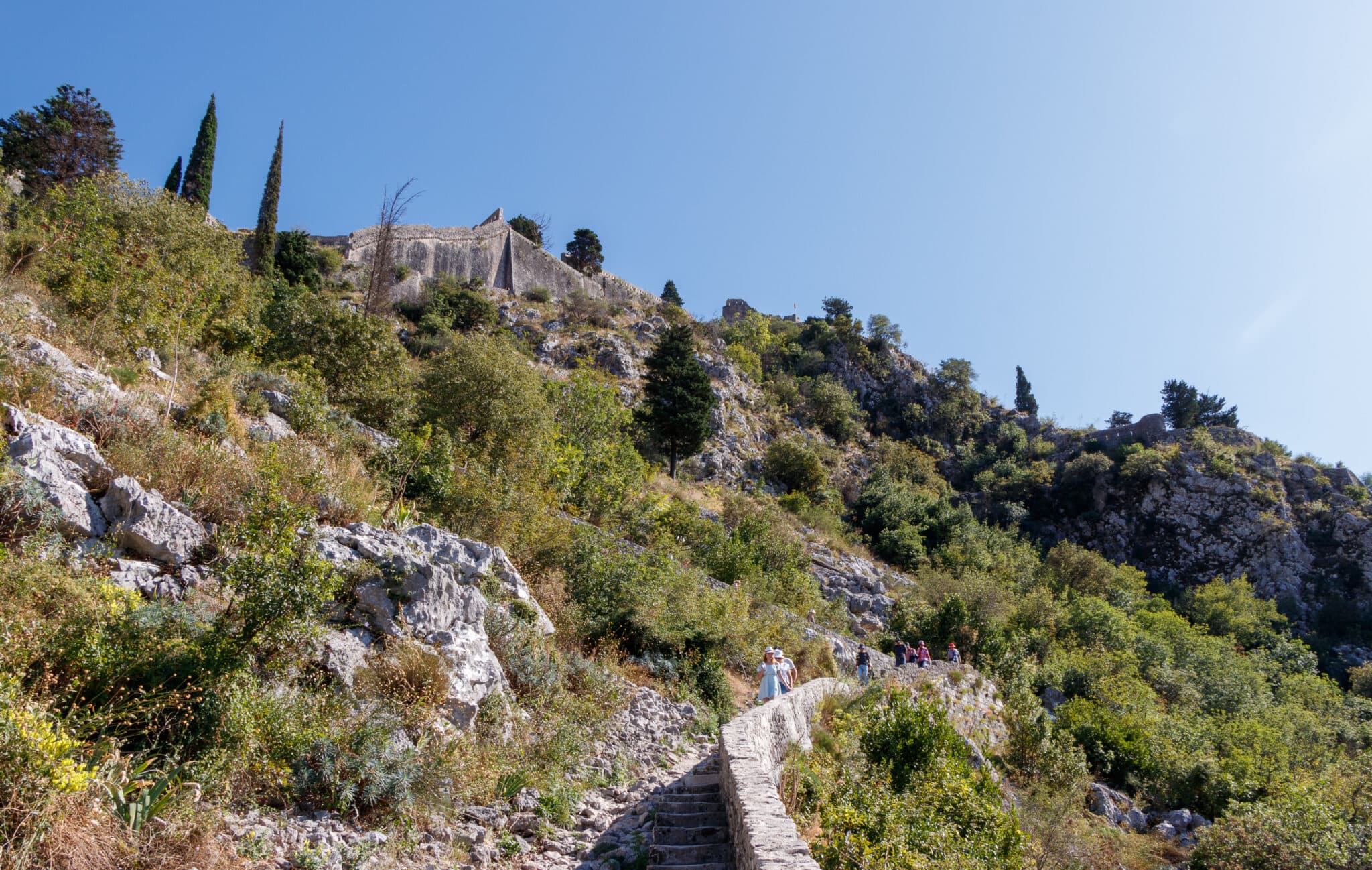
Not everyone gets to the top. But in vain. Yes, the climb is really heavy (although I have seen harder ones). But the views from the top are amazing. True, the fortress itself is not particularly special. Only ruins remain.
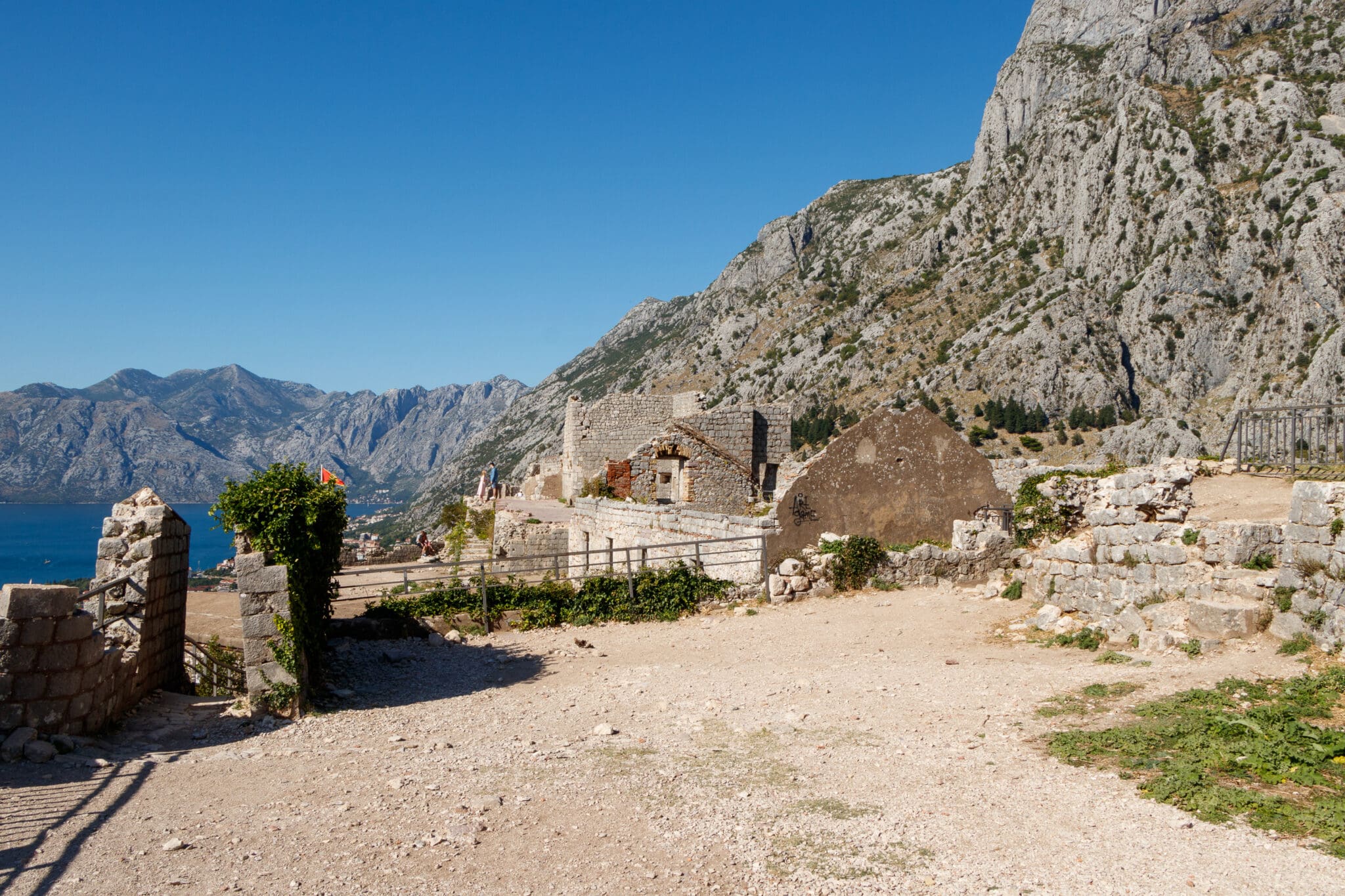
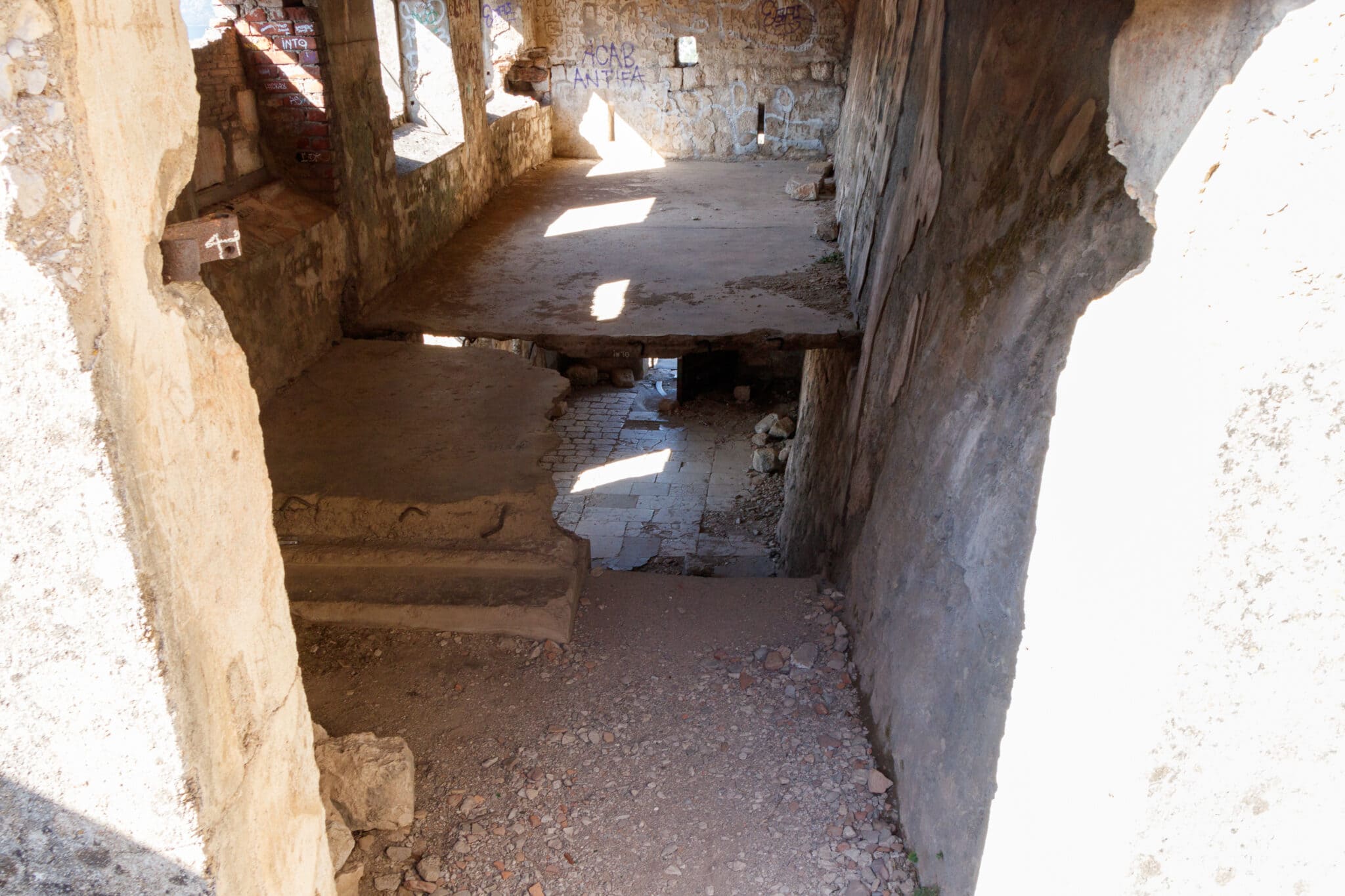
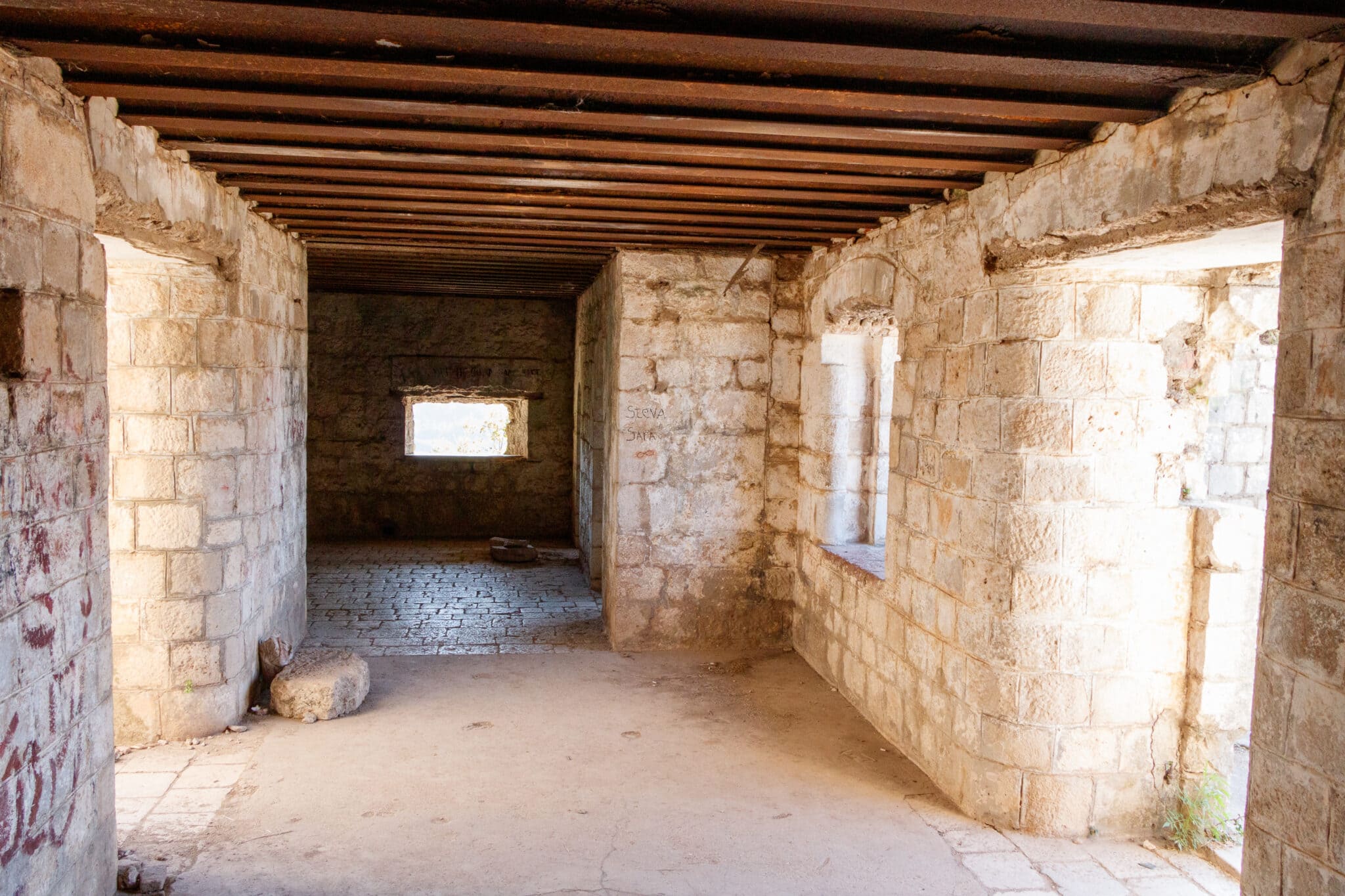
Hike to the Kotor fortress on a gentler trailhead (free of charge)
An alternative hike route to the Kotor fortress is on a free “Austrian” trail. It is flatter and noticeably longer. But the views will be slightly less impressive on the way up than from the ladder. But you will probably go alone. Periodically meeting grazing livestock.
Closer to the fortress itself, you will need to imagine yourself as a Turkish stormtrooper from the times of Barbarossa. And climb into the fortress through the “window”. But do not dive too deep into the role – climb into the lower one.
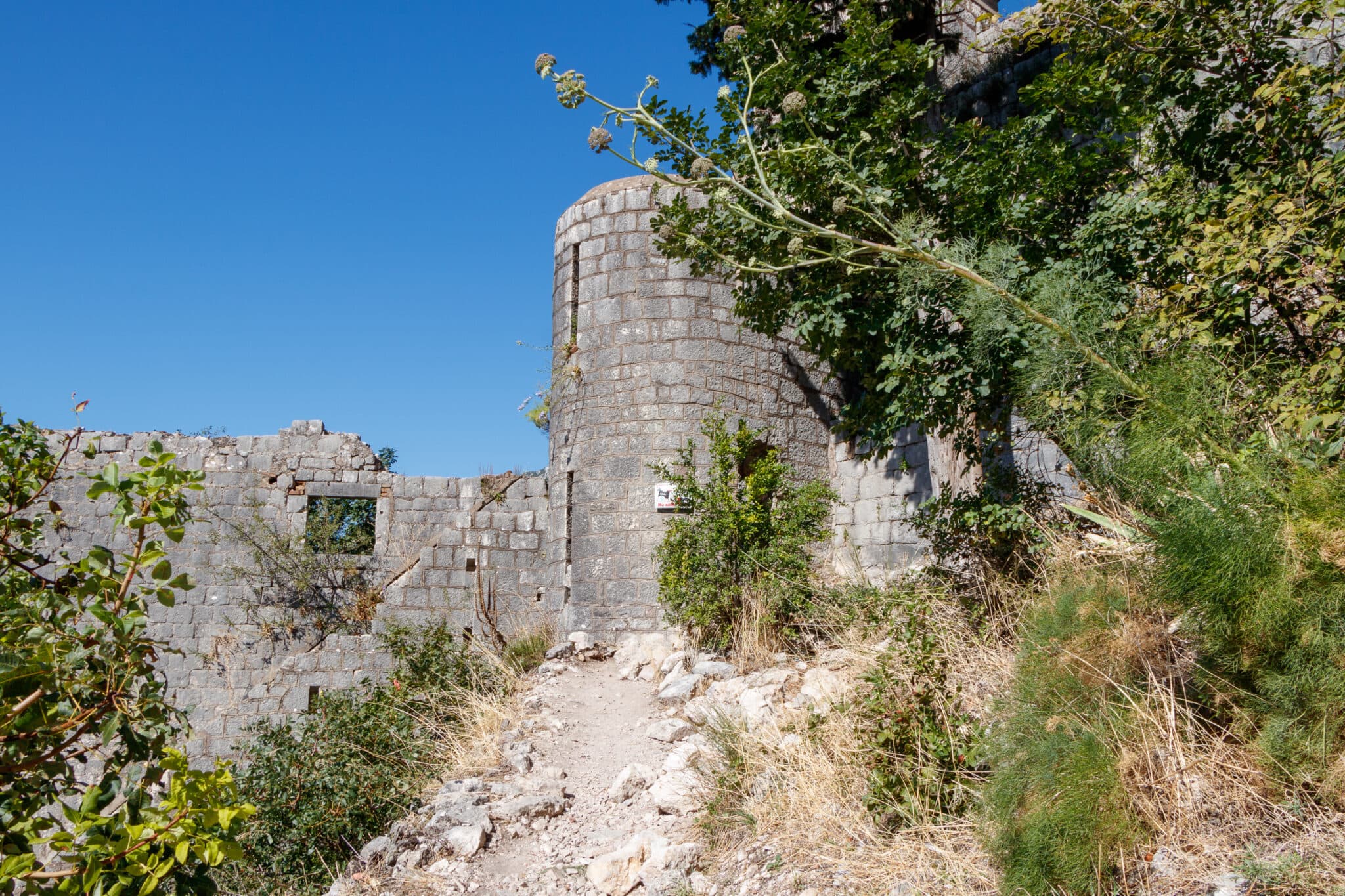
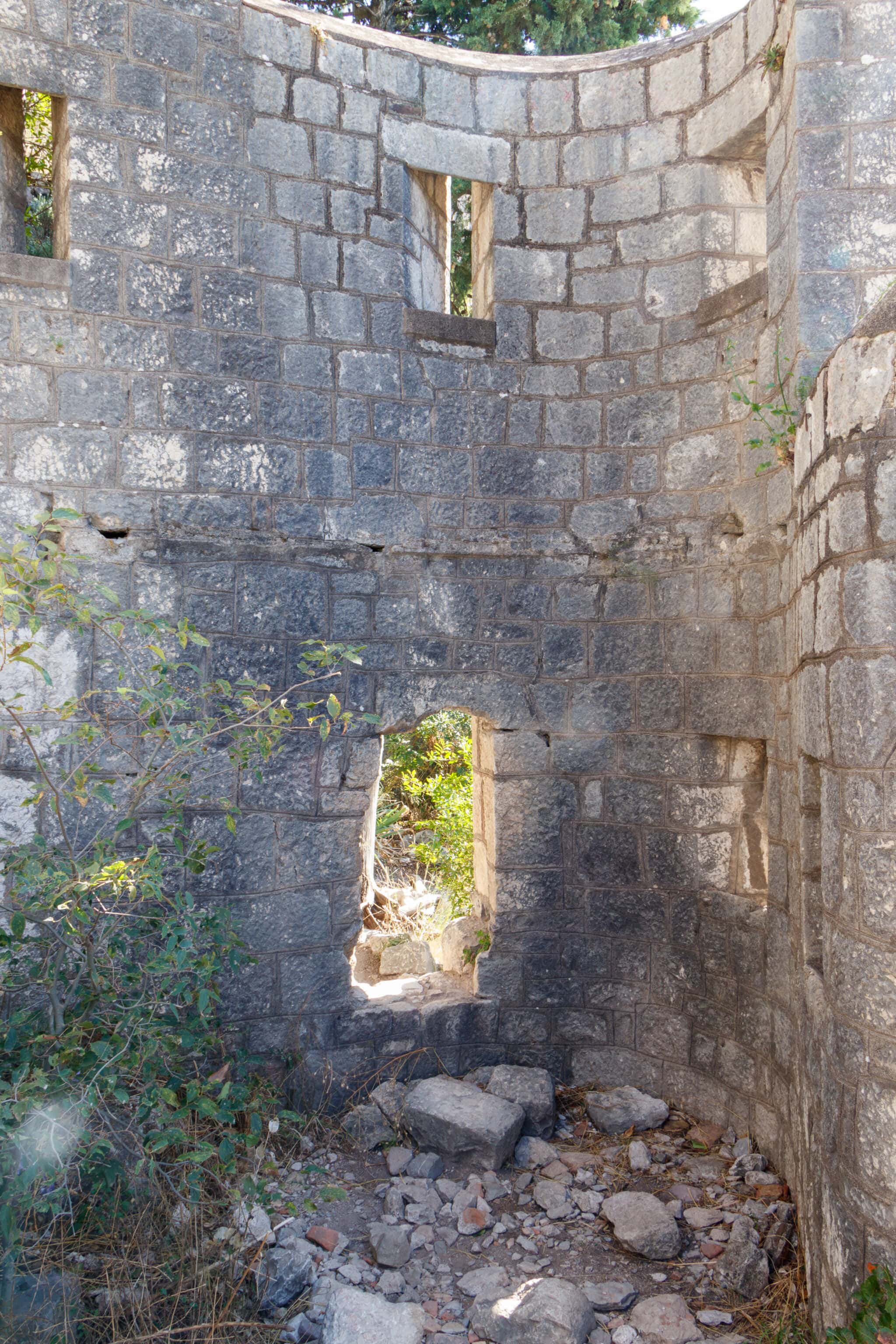
Both trails, paid and free, are not in the best condition, to say the least.
If you have a tough time going up the steep hill, you can hike slowly up the “gentle” “Austrian” trail. And go down back to the city by ladder.
In this way, you’ll both please your eyes with unreal beauty and save your heart.
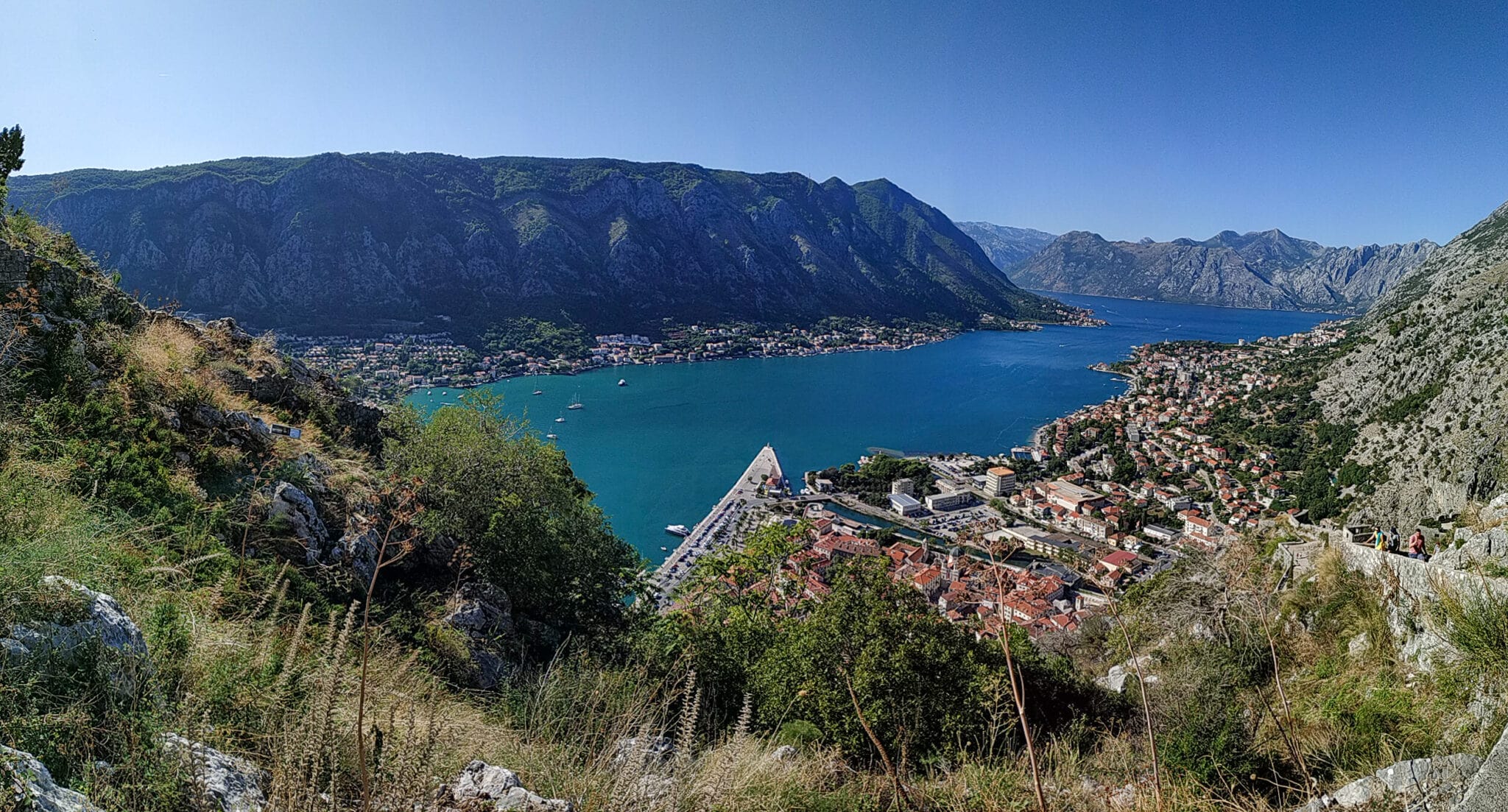
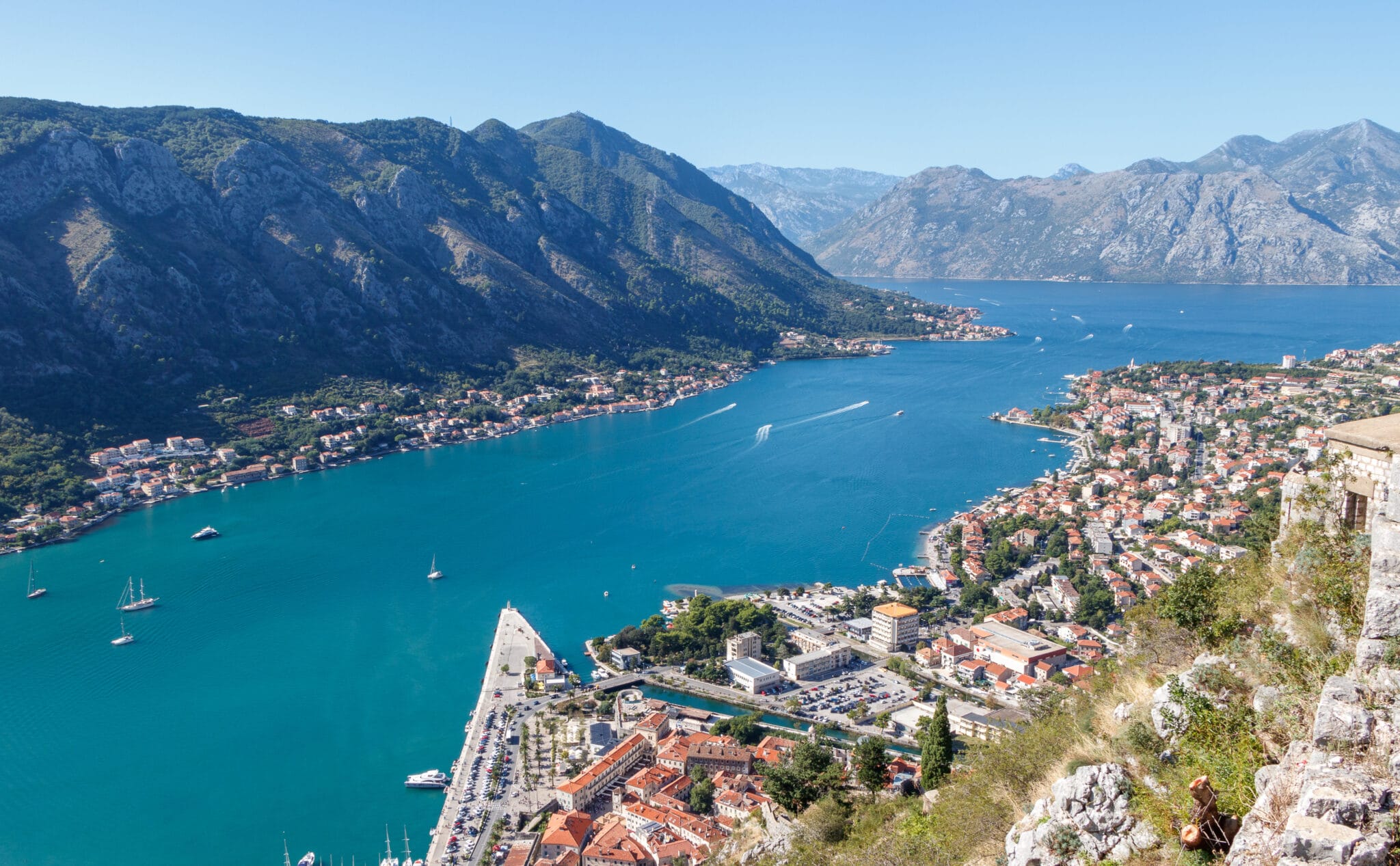
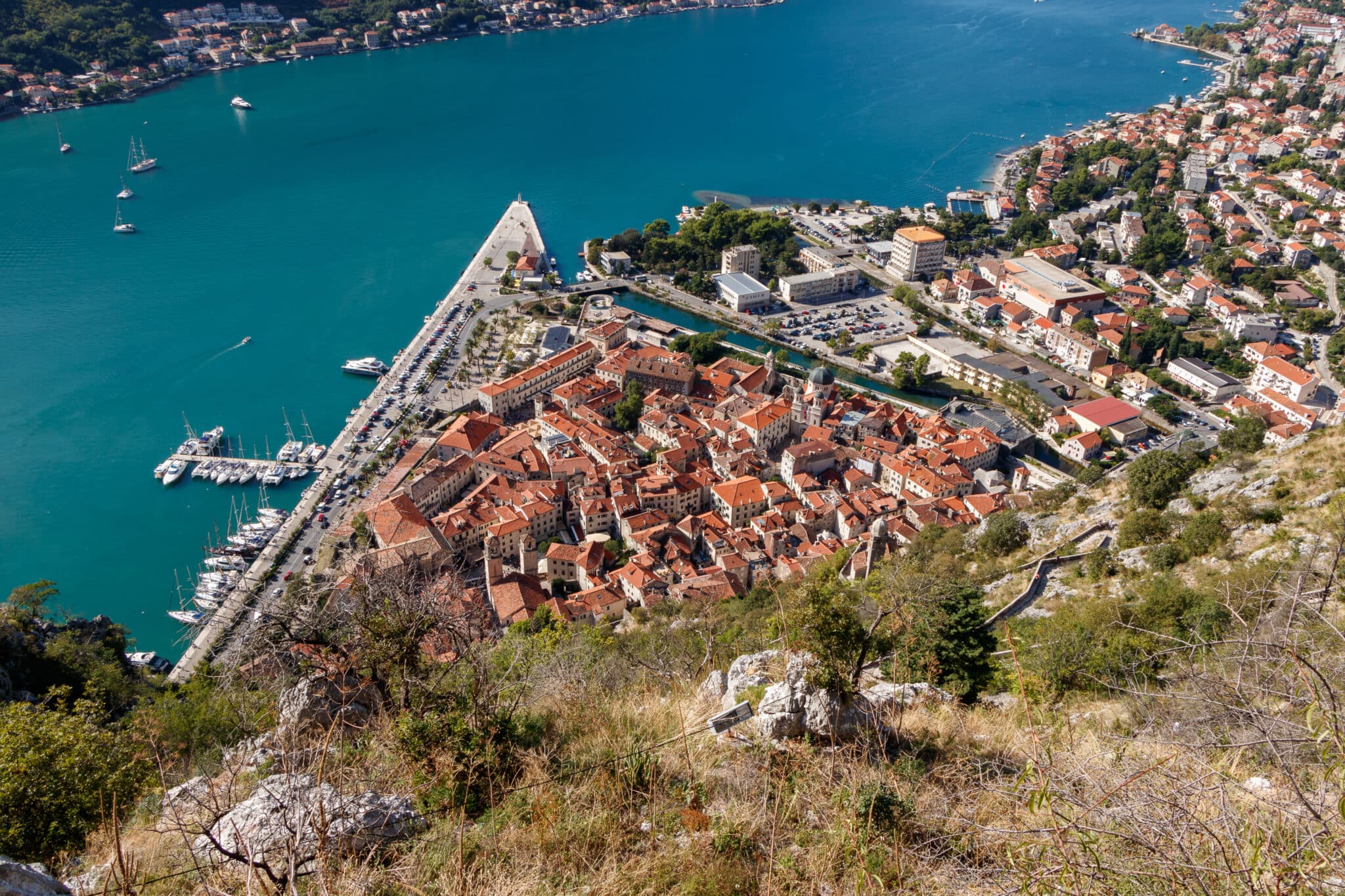
I’ve heard stories that you can turn from the free trailhead to the paid one 15 minutes after the ascent starts. And continue climbing up for free. To be honest, I found the only entrance to the main trail from the “Austrian” one not far from the top. To go there, to put it mildly, it’s a little more than 15 minutes. But maybe I missed something.
I also saw the news that they supposedly blocked the entrance to the fortress through the “window” from the free trailhead. It means that they should remove the stones on which you can climb into it. But, knowing Montenegrins a bit, it’s hard to believe in it. It is difficult to do this with just brute force. Lifting construction equipment is even more difficult. No one will do it in Montenegro if you don’t pay someone a lot.
Take at least 1.5 liters of water per person before climbing to the Kotor Fortress.
Otherwise, you will have to buy it at astronomical prices from local climbers with thermal bags.
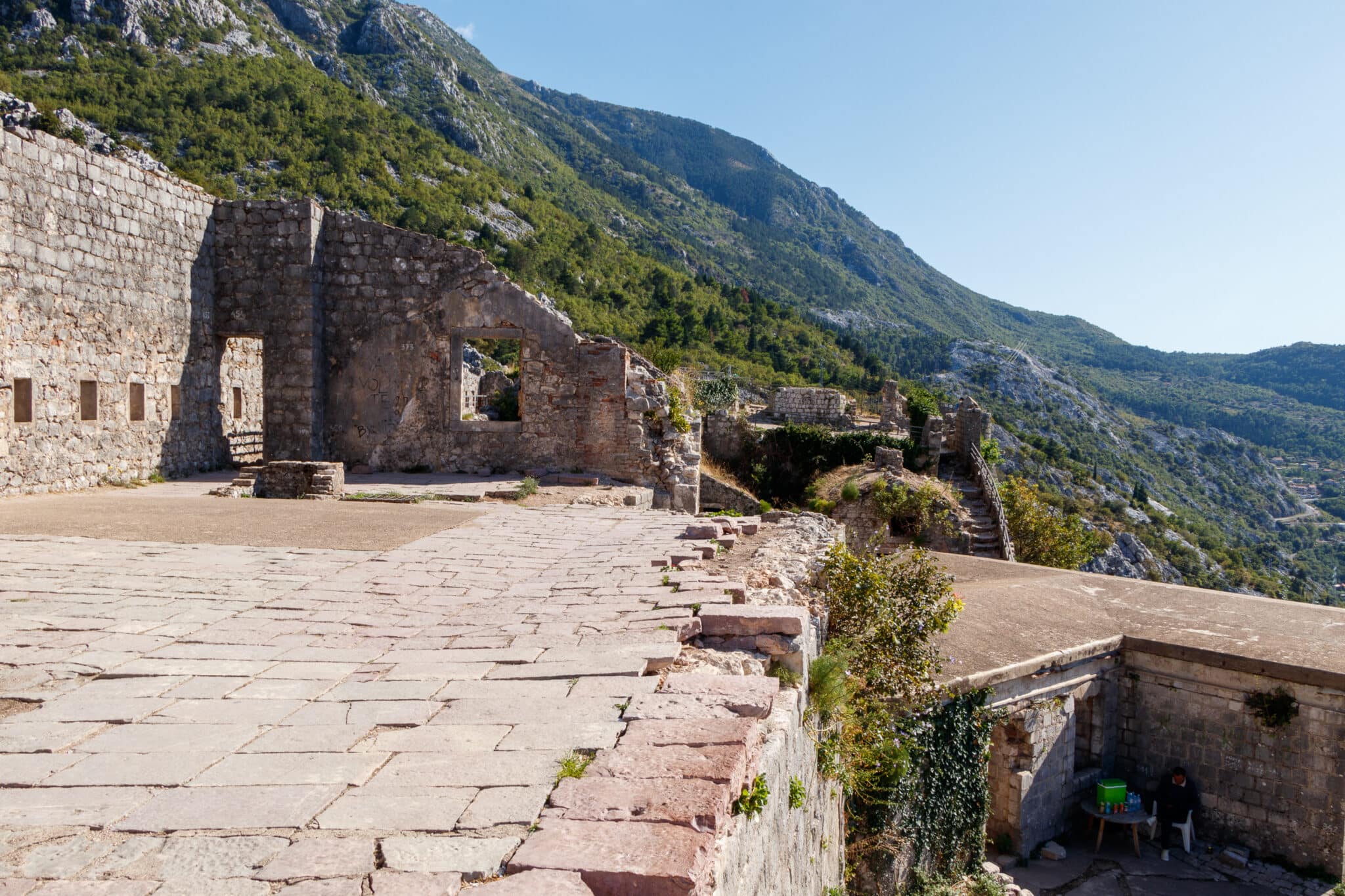
Those who did not take water with them before starting the ascent will greatly regret it halfway through. And at the top, you will be ready to give everything for a sip of water. That’s why the price here is about 3 times higher than down in the Old Town (where it is also by no means cheap).
By the way, when visiting the fortress, there are a number of rules and warnings. And oddly enough, insurance is even included in the ticket price.
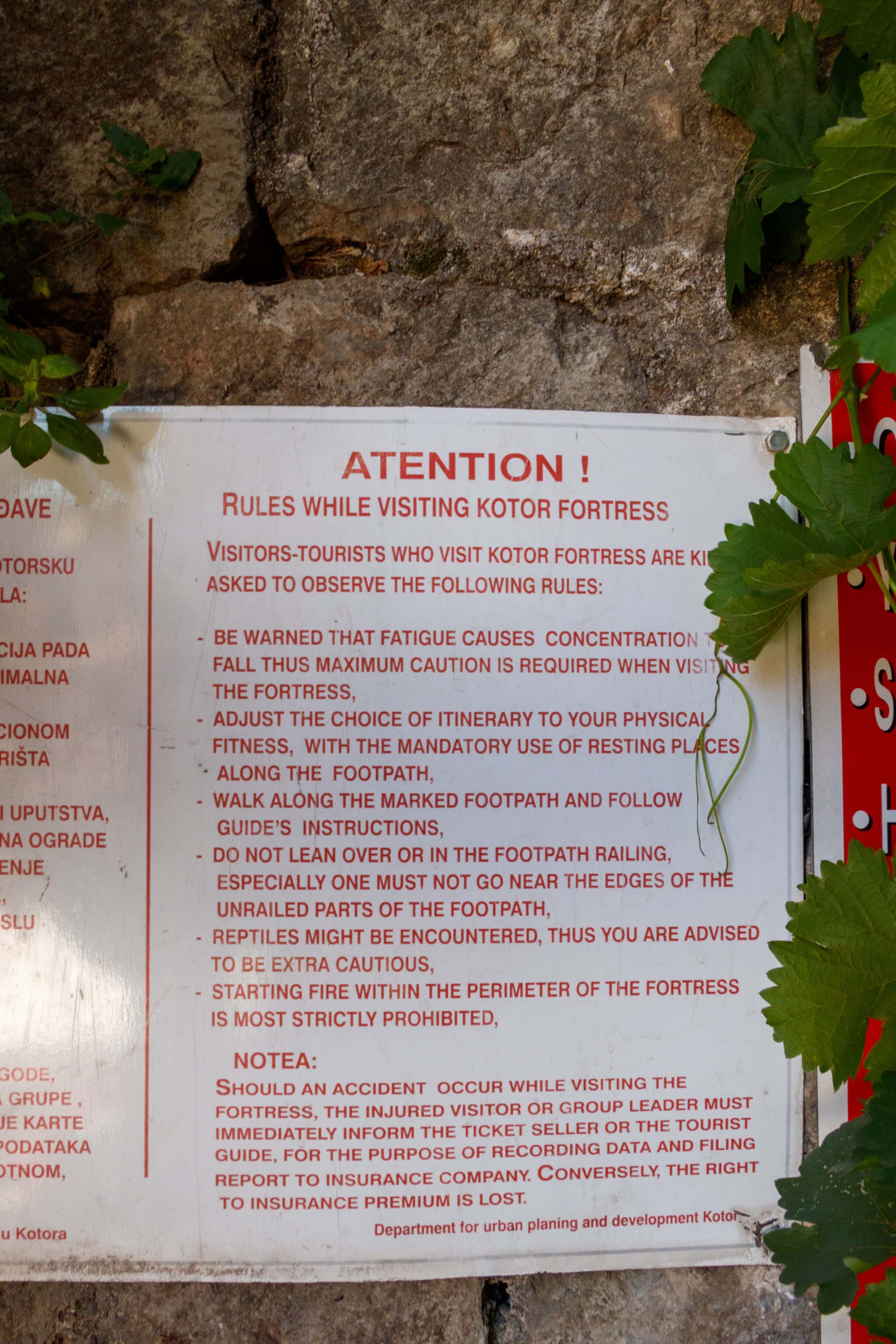
You won’t get to the Kotor Fortress with a group tour
Have you decided that you want to hike to the Fortress of St. John above Kotor and enjoy the fascinating views from it? Then it makes no sense for you to take a group tour to Kotor.
The ascent to the fortress and its descent will take significant time. And it’s not physically accessible to everyone. For these reasons, standard group tours do not include it. And, as a rule, they don’t even reserve time for you to run upstairs and back quickly. It may seem rather strange since climbing up to the fortress is one of the most exciting things to do in Kotor.
But it is as it is. If you want to climb to the fortress, you need to organize a trip to Kotor on your own. It is not difficult to do this. Bus connection with Kotor is well established. There are no problems getting to Kotor from popular cities on the coast of Montenegro or Podgorica. From Tivat, Budva or Herceg Novi, taking a taxi can be even more profitable option if several people are going.
Njegusi village
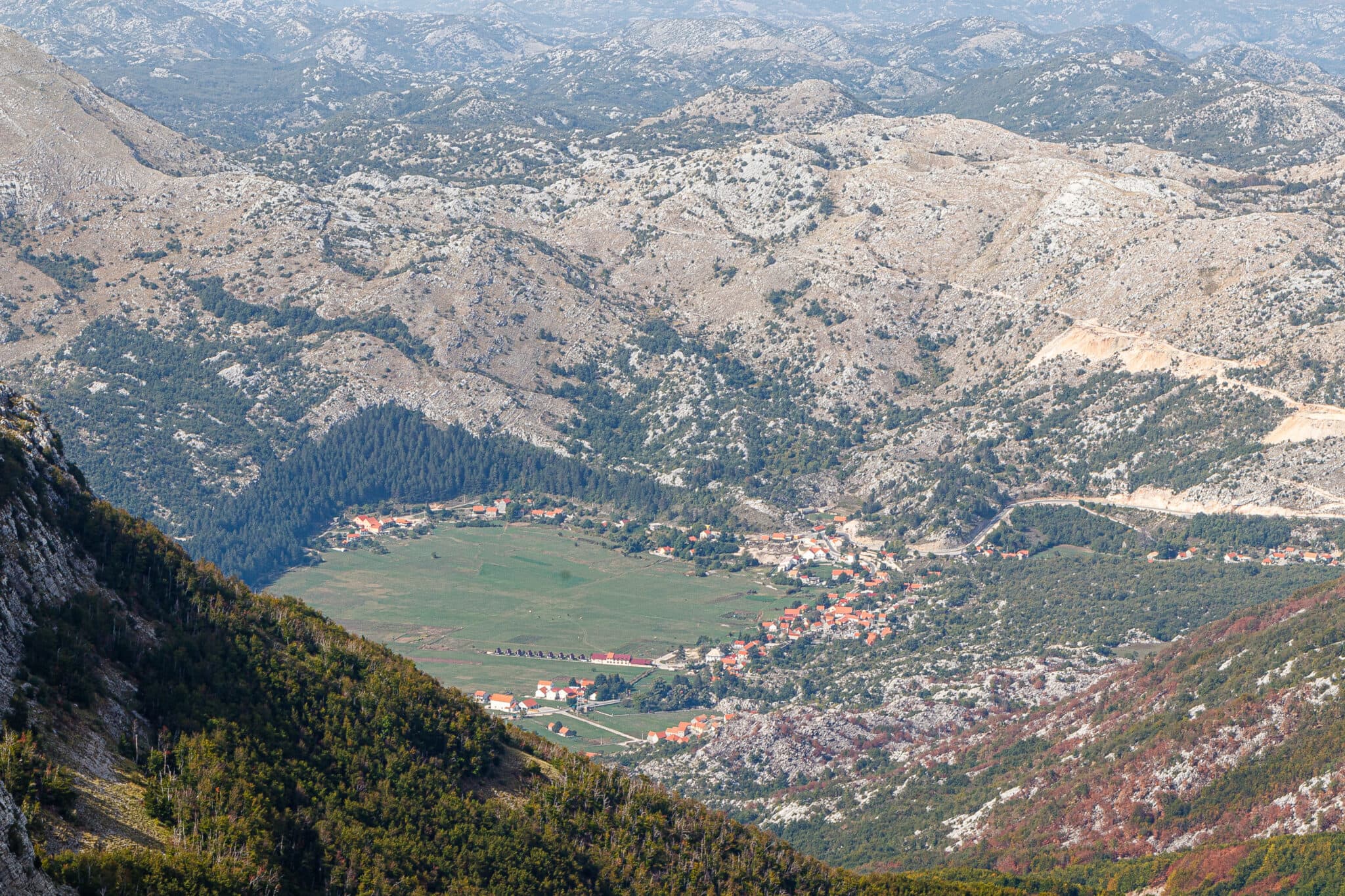
If climbing the ladder to the Kotor fortress suddenly felt like an easy walk to you (when I started my descending, I saw one such sportsman running up at the top :) ), you can continue climbing. At least to the village of Njegusi. It’s an ancestral village of the ruler of Montenegro – Petar II Petrovic-Njegos. Tourists are often brought here.
Among other things, here you can taste prosciutto and cheese, which is cooked here. Yes, it’s for tourists. But you can hardly find more environmentally friendly places to manufacture such products. Njegusi prosciutto, even from a supermarket, tastes very good.
The distance from Kotor to the Njegusi village along this hiking trail is 10 km. Ascent to a height of 1 km above sea level. Walking time is 3 hours, according to Google. I haven’t tried it myself.
Mount Lovcen and Njegos Mausoleum
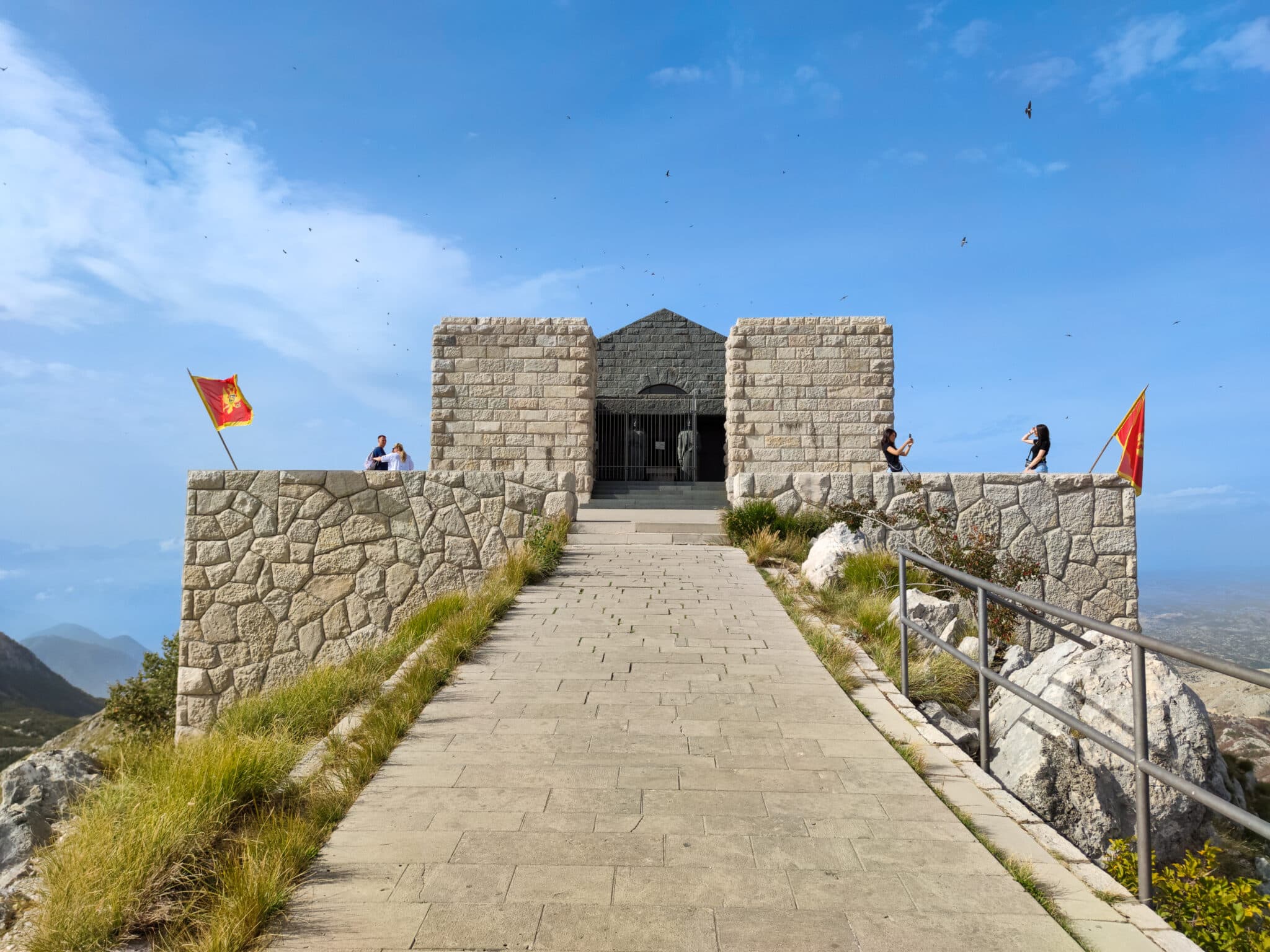
Even higher, there is the top of Mount Lovcen with an observation deck. You can see almost half of Montenegro from there (yes, I’m exaggerating a bit). Even further – there is the mausoleum of Njegos.
How to get to Lovcen National Park from Kotor?
All this is usually visited as part of bus tours. And more often through the city of Cetinje, where the road to Lovcen is easier. But the mountain serpentine from Kotor is a much more captivating experience. You can also get to this on foot. But it’s more likely with an overnight stay in a tent. One day is definitely not enough for this trail.
Important. If you want to see the panorama of the entire Bay of Kotor, including Perast, Herceg Novi, and the runway of the Tivat airport, you need to climb the car road serpentine towards the village of Njegusi. You will not see such a panorama from the hiking trail.
Cat Museum
You will meet a lot of cats in Kotor Old Town. They are the symbol of the city and its respectful inhabitants for ages. You can even visit a Cat Museum in Kotor. It’s a pretty small one. In this museum you can see interesting pictures of cats on different surfaces. This attraction is mostly for cat lovers.
Cat Museum in Kotor is located by address: Trg Gospa od Andela, Stari Grad 371. The ticket price is €1. Earned money is used to support local cats.
Cruise port
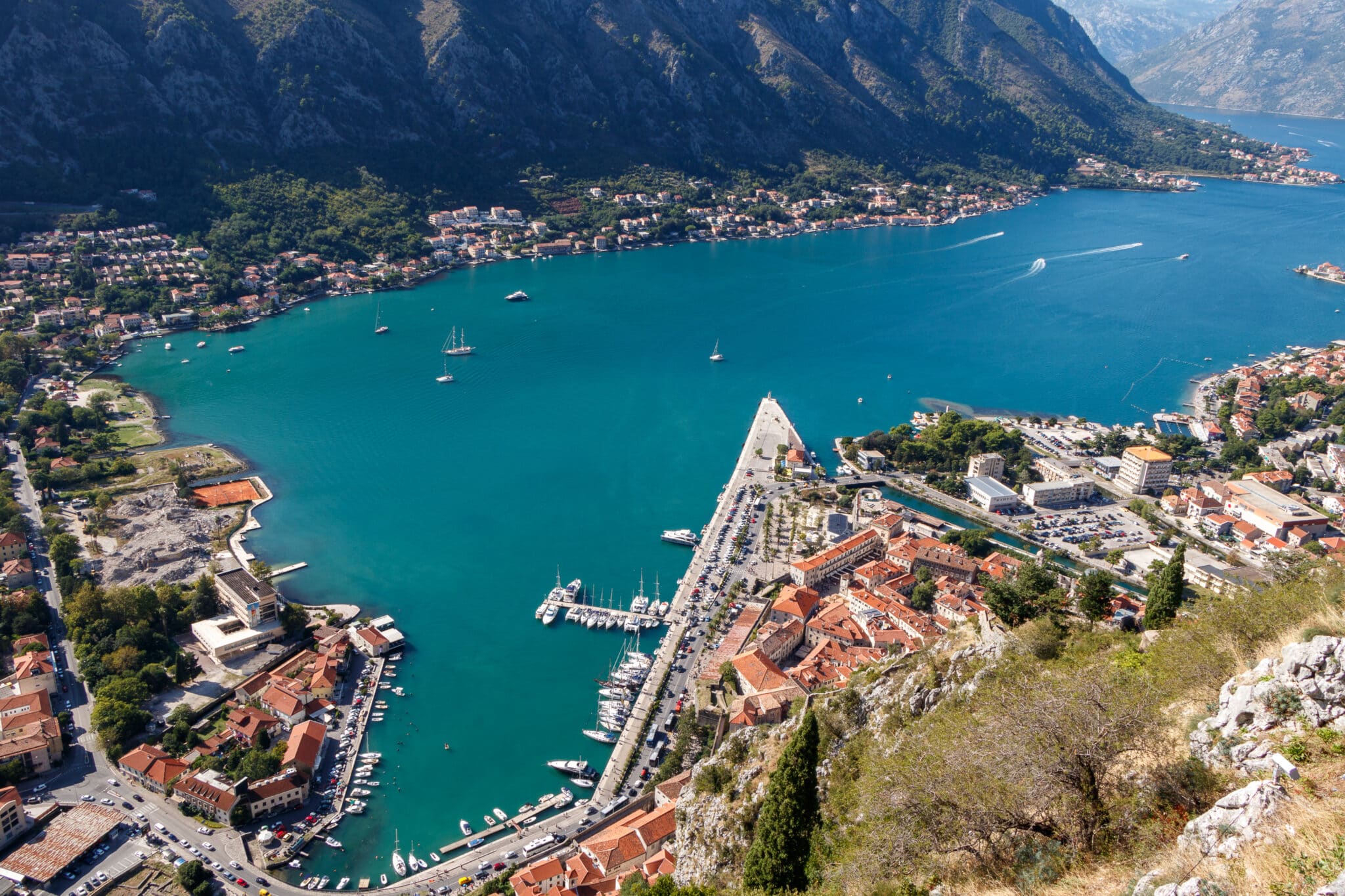
There is a cruise port in Kotor. Huge cruise liners regularly visit it. And crowds of tourists pour onto a pier at the same time. It’s one of the reasons why the composition of tourists in Kotor is the most multinational among all destinations in Montenegro.
Given the size of Kotor and the bay itself, the expression “an elephant in a china shop” involuntarily comes to mind. Almost like in Venice. But there, the entrance of cruise ships to the Venetian Lagoon is already closed. And in Kotor you may contemplate this picture, as before.
Freedom Park
Near the cruise port, there is a small Freedom Park, with a berth for small boats plying between settlements and tourist destinations of the Bay of Kotor.
Freedom Park is also one of the best places to contemplate the Bay of Kotor from the height of human growth, slightly away from the tourist bustle around the Old Town.
Paragliding
Paragliding is a popular thing to do in Kotor. And it’s pretty natural when you have terrific views but can’t see everything from the lower points. And you have a high mountain just above the town – the perfect place to arrange a paragliding excursion.
So how does paragliding works in Kotor, Montenegro? The take-off point is on Mount Lovcen at an altitude of 1380 m above sea level. You are taken there by car along the famous Kotor serpentine. Take off from there in tandem with “pilot”. Soar in the air for 15-30 minutes. The time depends on the weather and how loudly you will scream, begging for an immediate landing. Admire the incredible views. Try to keep diapers empty. Landing is on the football pitch in Kotor in the middle of the match between Brazil and Argentina.
Several companies organize this entertainment. Here are several websites to start:
Check them, and choose who you like most.
The standard price for a flight is €165. But you can try to look for cheaper options.
Tours and Excursions
Kotor, Montenegro is a city for excursions. But standard group tours do not allocate enough time for it. The routes are designed in such a way that they watch Kotor in the “run, run, faster” mode.
Therefore, even for those who prefer to simplify the process by just buying a group tour, I would advise not to do it in the case with Kotor. You can come there on your own and see everything without guides. It’s pretty simple.
Find a good individual guide if you still want additional information about Kotor, its sights, interesting stories, etc. In the case of Kotor, this is a fairly common practice.
Often a visit to Kotor is combined with visiting Perast, located nearby. That’s how I did. From my experience – it is possible, but this is a time-pressure format. Not very comfortable. If you have time, it’s better to set aside a separate day for Kotor. If free time is left, you can, for example, take an evening boat trip along the Bay of Kotor. And go to Perast the other day.
Another good option is to spend the night in Kotor. You can even stay in a hostel right in the Old Town.
Tours from Kotor
Tours and excursions from Kotor are primarily relevant for those who decide to settle here and not in one of the resorts on the coast. They do that too. There are enough apartments both in the Old Town and the modern part of Kotor. So where can you go from Kotor, and what are the main points of interest?
Perast
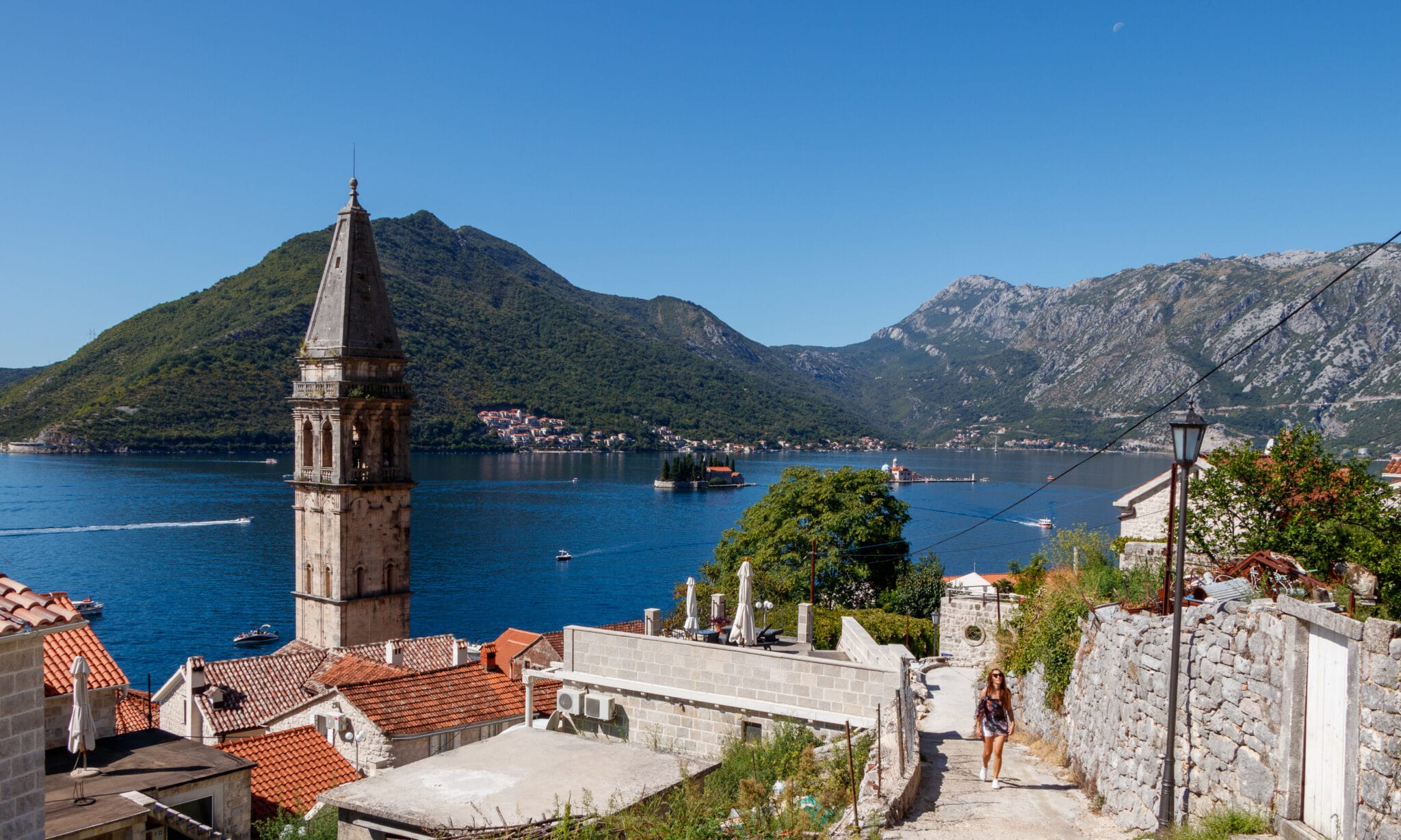
The medieval town of Perast is the second must-see attraction in the Bay of Kotor. Just like Kotor, it is a city with a glorious history, well preserved as a whole. Just one fact from its history. The flag of the Venetian Republic was buried Perast after it ceased to exist “thanks” to Napoleon.
Perast is probably located in the most beautiful place in the Bay of Kotor, opposite the Verige Strait. Also opposite are two small islands – Gospa od Shkrpela (artificial) and St. George (of natural origin). On the first, you can visit the Our Lady of the Rocks church. And swim around the Benedictine monastery on the second one (it’s not allowed to visit St. George island).
There are many ways to go from Kotor to meeting with Perast. They are not far from each other – 12 km by land and a little less than 10 km by water. There is a bus, scheduled boats, and private boats. You can also take a taxi. Or visit Perast as part of a Bay of Kotor tour or a larger group excursion. And unlike Kotor, visiting Perast as part of a group tour is an acceptable option.
There are certain nuances with a self-guided trip to Perast. Therefore, a bit lower, I will tell you in more detail about how to get from Kotor to Perast and back.
Blue Cave and Mamula Island
The Blue Cave and Mamula Island are located at the entrance to the Bay of Kotor from the Adriatic Sea. Tours to these sights from Kotor are exclusively by sea. And this means you have to sail the entire Bay of Kotor there and back.
Mamula Island
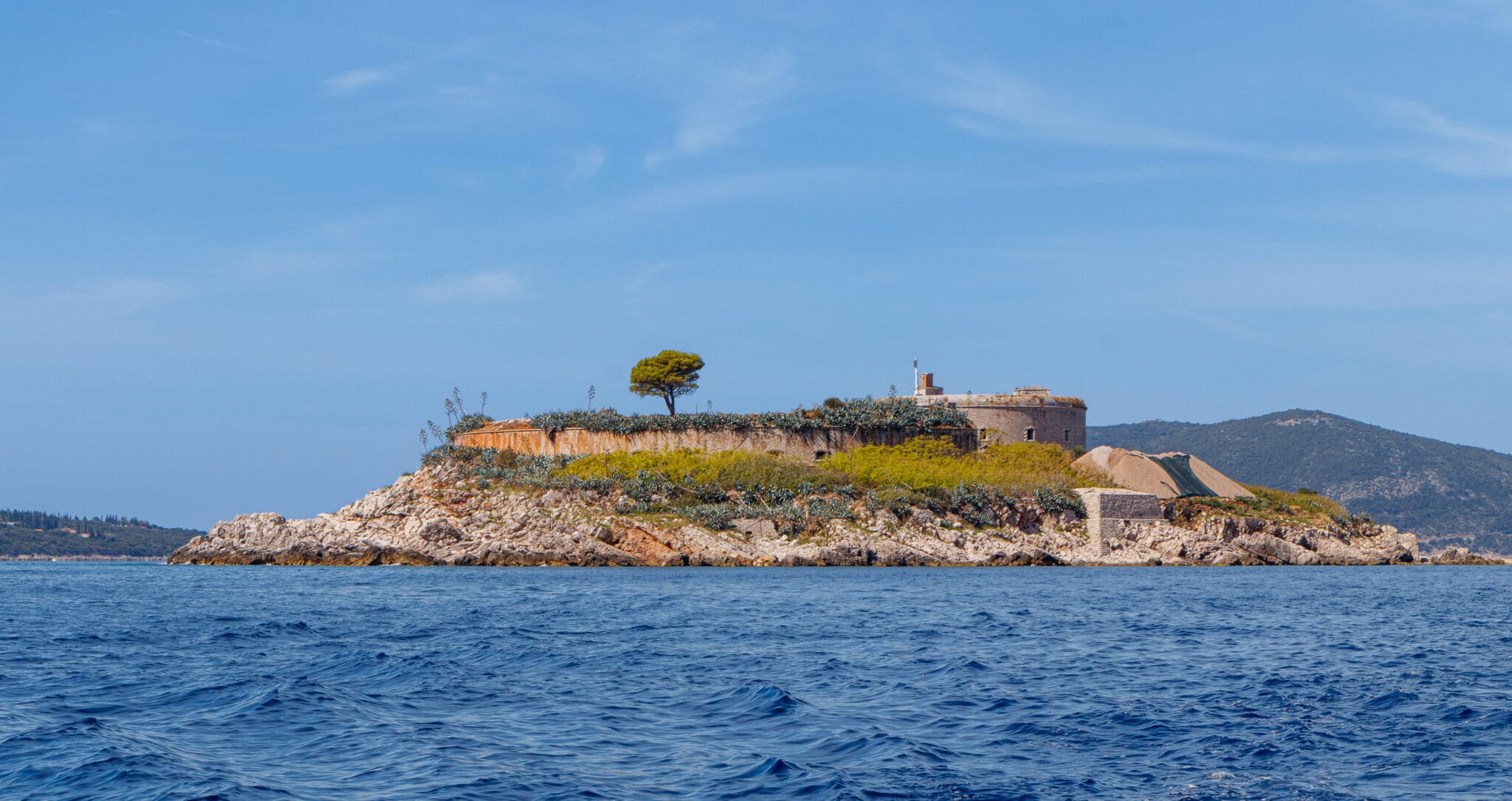
The entire small Mamula Island is a fortification. More precisely, what was left of it. It was named in honor of the Austro-Hungarian commander Lazar Mamula. Not all tours to Mamula Island include the opportunity to go ashore. Check this point before buying an excursion.
The Blue Cave
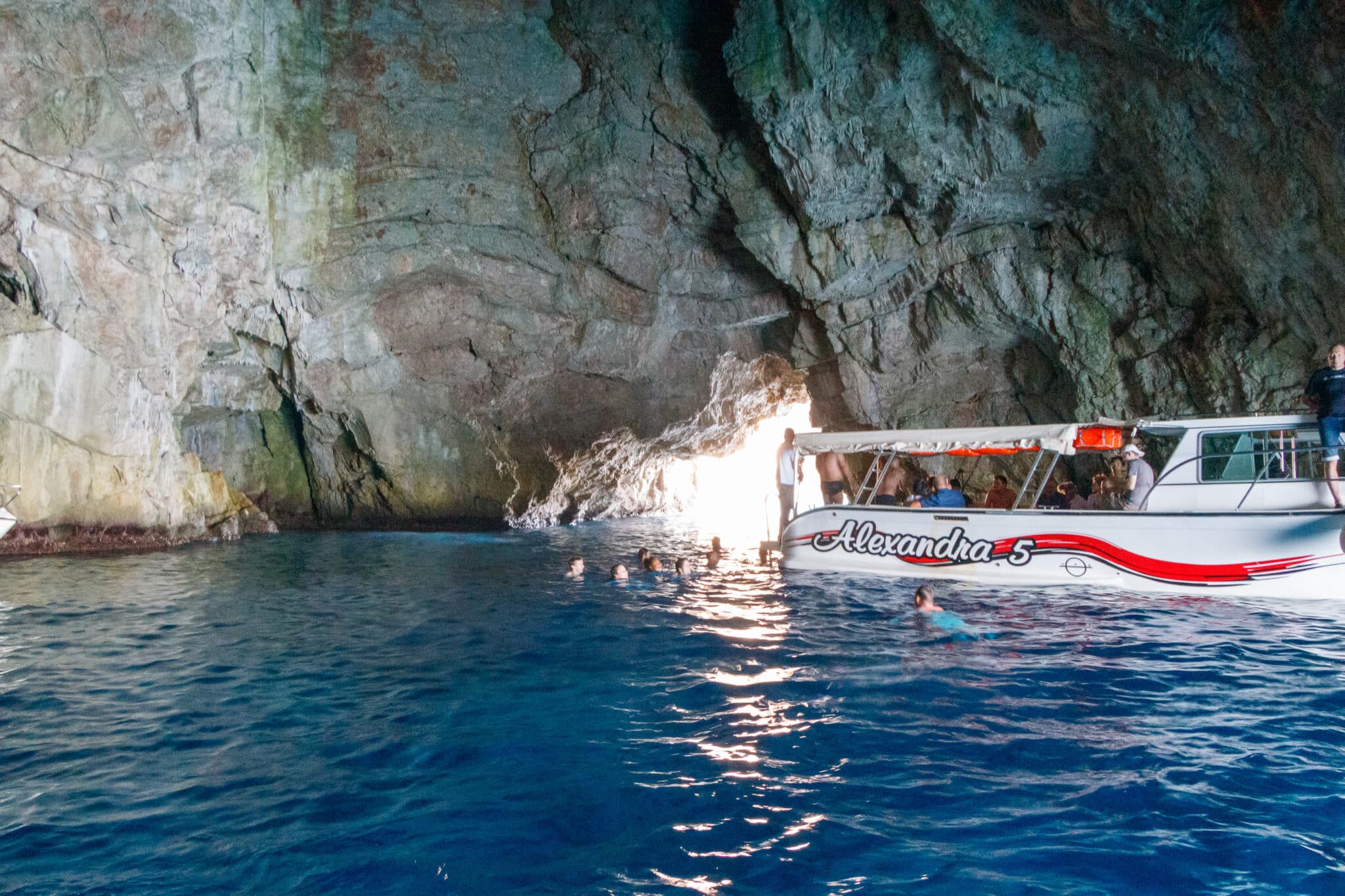
The Blue Cave is a cavern with a high “ceiling” and two “entrances”. On a clear day, the sun’s rays penetrate the cave, creating an unusual blue tint to the water. Looks beautiful. You can swim in the Blue Cave. The lower boats float in. The larger ones moor next to it. And you need to swim inside using your hands and legs.
I got acquainted with these places while relaxing on the nearby Zanjice beach – one of the few comfortable ones in the Bay of Kotor area. And I sailed there from Herceg Novi, which is much closer to Mamula Island and Blue Cave than Kotor. Travel time was approximately 1 hour. So you can roughly estimate how long the journey from Kotor will take. Although the boats are different, and the time can vary significantly.
Lovcen National Park
Lovcen National Park literally hangs over Kotor. You just need to jump high, and you are already there :)
This National Park of Montenegro is known for a few popular tourist places – Njegos Mausoleum with an observation deck, Njegusi village, and a couple more observation platforms. But this is a large National Park where there is a lot more. And where you can hardly get with group excursions. They simply do not reach because of lack of time.
There are two main roads to Lovcen National Park. More precisely – to the top of Mount Lovcen. A more comfortable road is from the city of Cetinje. It is flatter and in the standard two lanes wide. The views are beautiful but not dazzling.
The second road leads to Lovcen from Kotor along a steep mountain serpentine. The views are mesmerizing. But the road is very narrow in some places. Sometimes the passage of two cars is challenging. If you are an inexperienced driver, it is better not to drive from Kotor. But if you’re lucky enough to have someone with reasonable confidence in their driving skills, and you don’t forget to bring diapers, welcome to one of the most scenic mountain roads in Europe.
Well, just in case, I will mention that the road is through. It means that you can get from Kotor to Cetinje via Lovcen.
There are no regular buses to Lovcen either from Cetinje or from Kotor. But here and there you can be taken to Lovcen by regular taxi drivers. Usually, it costs from €25, with around two hours of time included. The road itself will take approximately 40 minutes of this time. If you need more time and be more flexible – negotiate according to the situation. There are group tours that include Cetinje, Lovcen, Kotor and the Bay of Kotor. But it’s in the “run, run faster” format.
Dubrovnik (Croatia)
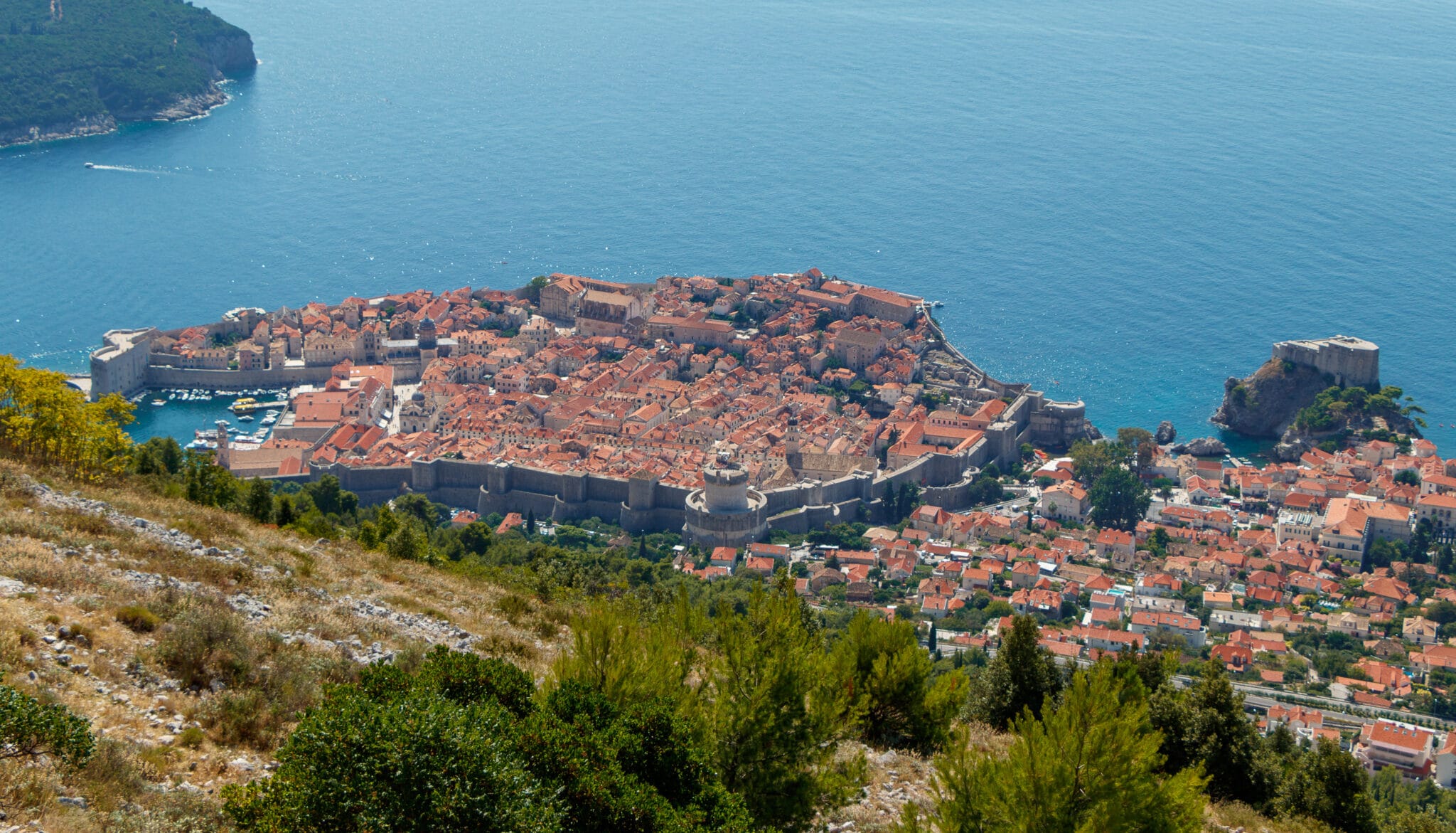
The Croatian city of Dubrovnik on the Adriatic Sea is near the Montenegrin border. And relatively close to Kotor. It is the most popular day trip destination from Montenegro. And it’s really worth it. I absolutely recommend you to visit Dubrovnik. But it’s better not with a group tour and not for one day only.
Dubrovnik is known to many as King’s Landing – the capital of the Seven Kingdoms.
But some people also know it as an ancient city with a rich history. Perfectly preserved, despite numerous attempts to destroy it. The last time the Serbs tried to do this was in the 90s of the XX century. By the way, a museum is dedicated to these events, located on a mountain above the city. I recommend you visit it if you have time. In addition to the museum’s expositions, from its terrace you will see a delightful panorama of Dubrovnik, along with the island of Lokrum and its surroundings.
Regular buses run from Kotor to Dubrovnik. Time to get to Dubrovnik by bus – 2.5-3 hours. It can significantly depend on the time it takes to cross the border. This, in turn, greatly depends on what time of year you are traveling.
Mostar City and Kravice Waterfalls (Bosnia and Herzegovina)
A day trip to the ancient city of Mostar and Kravice Waterfalls in Bosnia and Herzegovina is one of the popular day trips from Montenegro.
These places are beautiful and entourage. But the tour can be exhausting because of covering long distances. The Kotor’s benefit is that it is quite close to the border with Bosnia and Herzegovina. Therefore, travel time is slightly less than from resorts on the coast.
There is a direct bus from Kotor to Mostar. Travel time – 5h. Ticket price – €24. It’s a shorter route. There is also a longer one – it goes along the coast of Montenegro and further through Podgorica. Travel time – 9 hours. Ticket price – €27.
Albania
Day trips from Montenegro to Albania are pretty popular. But Kotor is far from the border with Albania. And in the case of a bus tour, you need to move out very early.
Yes, there is Tivat airport around the corner. But as of 2025, there is still no direct flights to Albania on the schedule. And it is understandable – the flight time is just 15-20 minutes. It makes little sense to launch such a flight even though it could be handy.
There is a direct bus from Kotor to Shkoder in Albania. It goes for about 4 hours. Ticket price – €17.
In general, I definitely recommend visiting Tirana and Shkoder in Albania, with their surroundings. But better not from Montenegro. Better either before coming to Montenegro or before returning home after a trip to Montenegro. Accordingly, arriving or departing to/from Tirana airport. Well, or just somehow plan a full-fledged trip to Albania.
Beaches
Kotor – it’s not about a beach holiday. Yes, there is a small city beach in Kotor. But swimming there is not recommended. You can’t expect clean water next to such a busy port. So most people come to the beach to sunbathe.
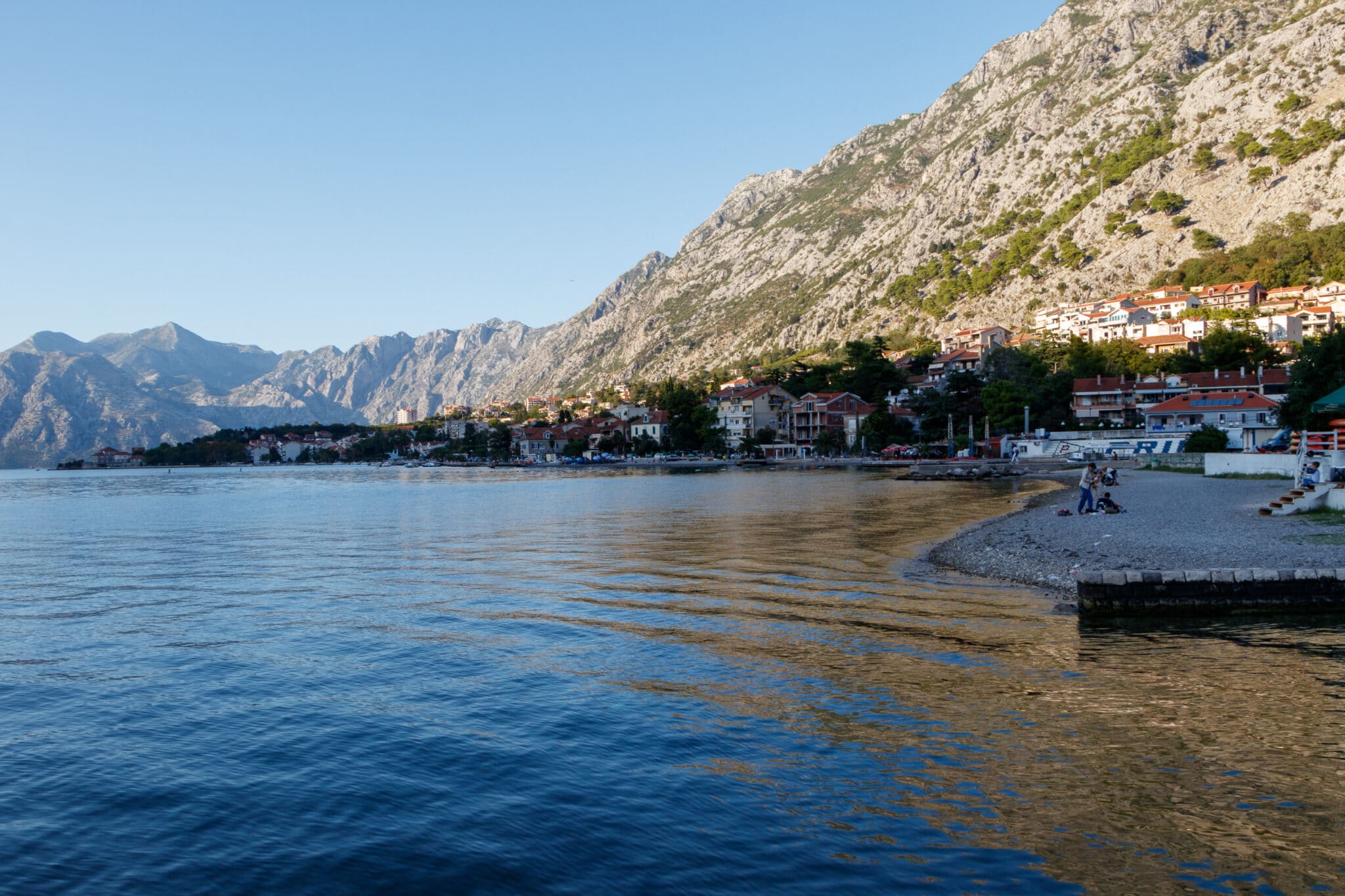
If you still want to swim in the Kotor area, then it makes sense to consider the beaches of the neighboring town of Dobrota. Or go a little further – to the small Donji Orahovac village.
Another option to swim in really clear water on a good beach while having a rest in Kotor is to go directly to the Adriatic coast. There are two good beaches in the distant vicinity – Zanjice (pebble) and Plavi Horizonti (“Blue Horizons”) – sandy. They are not close. First, you need to sail through the entire Bay of Kotor. Or by regular sea transportation, with a connection in Perast, to Herceg Novi. And then on the boat.
You can get to Plavi Horizonti from Kotor by regular bus. But it goes from Tivat. So first you need to get there. The bus from Tivat goes to the Radovichi village, located near the beach.
Weather
The weather in Kotor is about the same as in general on the Montenegrin coast. Since the city is surrounded by mountains, the average temperature is slightly lower than directly on the Adriatic coast. A bit.
The table below shows the average day and night air temperature, the water temperature and the number of rainy days for each month. This information about the weather in Kotor will be most useful when choosing the best time to visit Kotor.
Weather in Kotor, Montenegro by months
| Month | Temperature, day/night, °C | Water, °C | Rainy days |
|---|---|---|---|
| January | 6.9/2.9 | 14.6 | 8 |
| February | 8.2/4.5 | 13.9 | 8 |
| March | 10.9/6.6 | 14.0 | 7 |
| April | 14.6/9.6 | 15.4 | 7 |
| May | 19.3/12.3 | 18.9 | 8 |
| June | 24.5/15.8 | 22.9 | 6 |
| July | 27 .5/18.4 | 25.3 | 3 |
| August | 28.6/19.4 | 26.2 | 2 |
| September | 23.2/16.5 | 24.2 | 6 |
| October | 19.1/12.8 | 21.5 | 6 |
| November | 14.4 /9.9 | 19.4 | 8 |
| December | 8.9/4.7 | 16.9 | 7 |
Don’t be fooled by the fact that you can’t see air temperatures above 30°C in the table, even in July and August. The average temperature is indicated. In reality, from about mid-June to mid-September, it’s very hot in Kotor on a sunny day. It’s better to plan climbing to the fortress at this time of the year in the morning (preferred option) or in the evening.
Despite the relatively large number of rainy days in Kotor in June and September, there are nuances. In the first half of June, indeed, it can rain. But unlike the first half of May, rains are mostly short and light.
The weather in Kotor in September varies significantly in the first and second half of the month. Rains in the first half of September are pretty rare. But towards the end of the month, they may become frequent and prolonged – the risk of getting into uncomfortable weather increases.
Best time to visit Kotor, Montenegro
I visited Kotor closer to the end of September. It was full of tourists. What happens in the high season is hard to imagine. You can see it in photos of other tourists.
In September, it was possible to get to the city without any problems. There were no significant bottlenecks. In summer, the situation on the road is not so favorable. Leaving the car somewhere near the Kotor Old Town, even in September, is a mission impossible. The Old City was very crowded and sometimes overcrowded.
The ladder to the fortress is designed for a more or less comfortable climbing in a single file. Neighbor lane is mostly strewn with large stones.
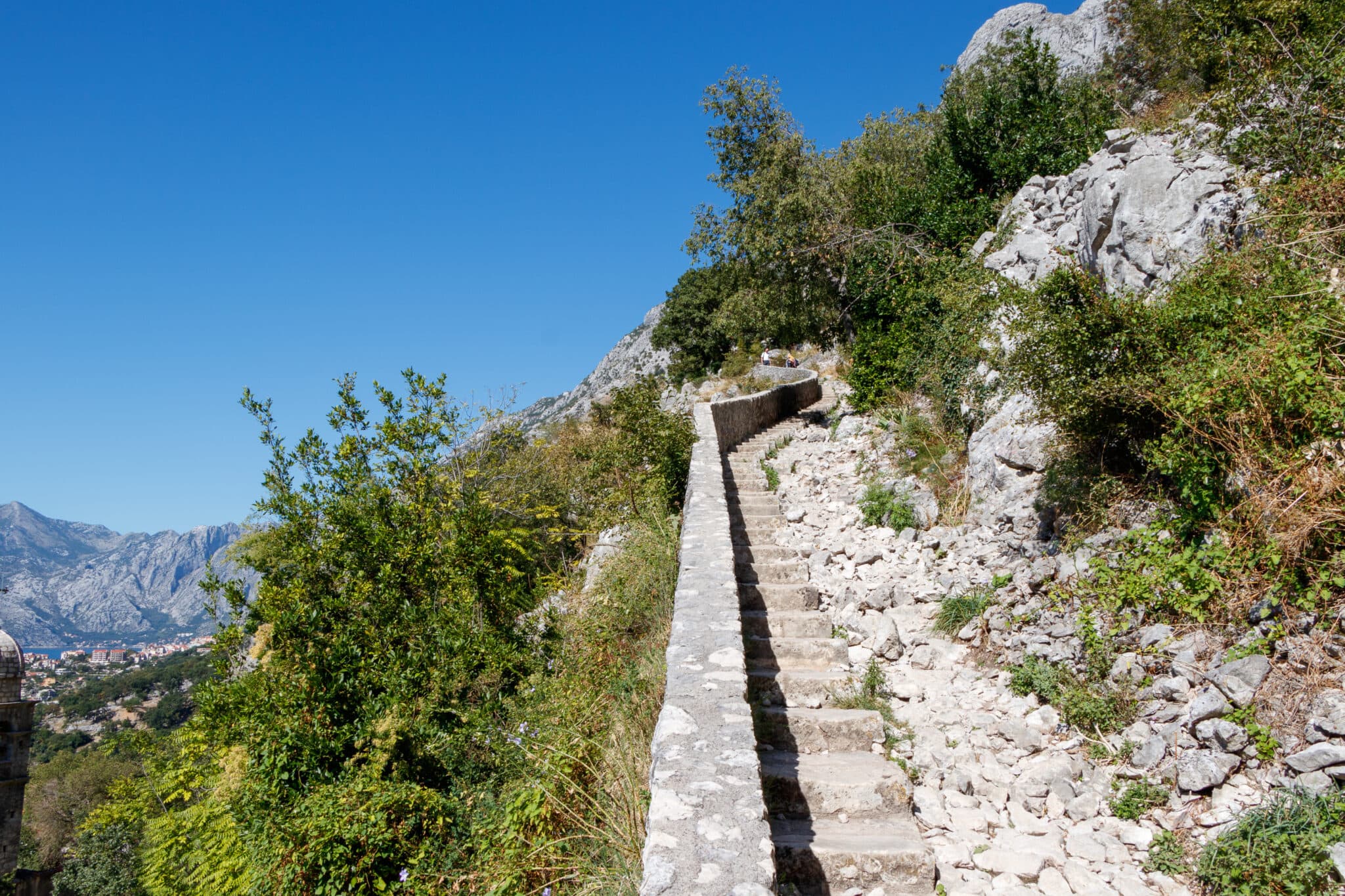
Even going down this lane is very inconvenient. And climbing is mostly extreme. And you must remember that people not only climb but also descend. Each such mountain “passage” creates inconvenience. You can imagine what happens with a continuous flow of people in the high season. So:
I recommend visiting Kotor in the low season. The best time is May or September.
Hotels and Apartments
There are two main types of accommodation in Kotor, Montenegro – located in historic buildings in the Old Town and modern buildings outside it. Old Town also has hostels.
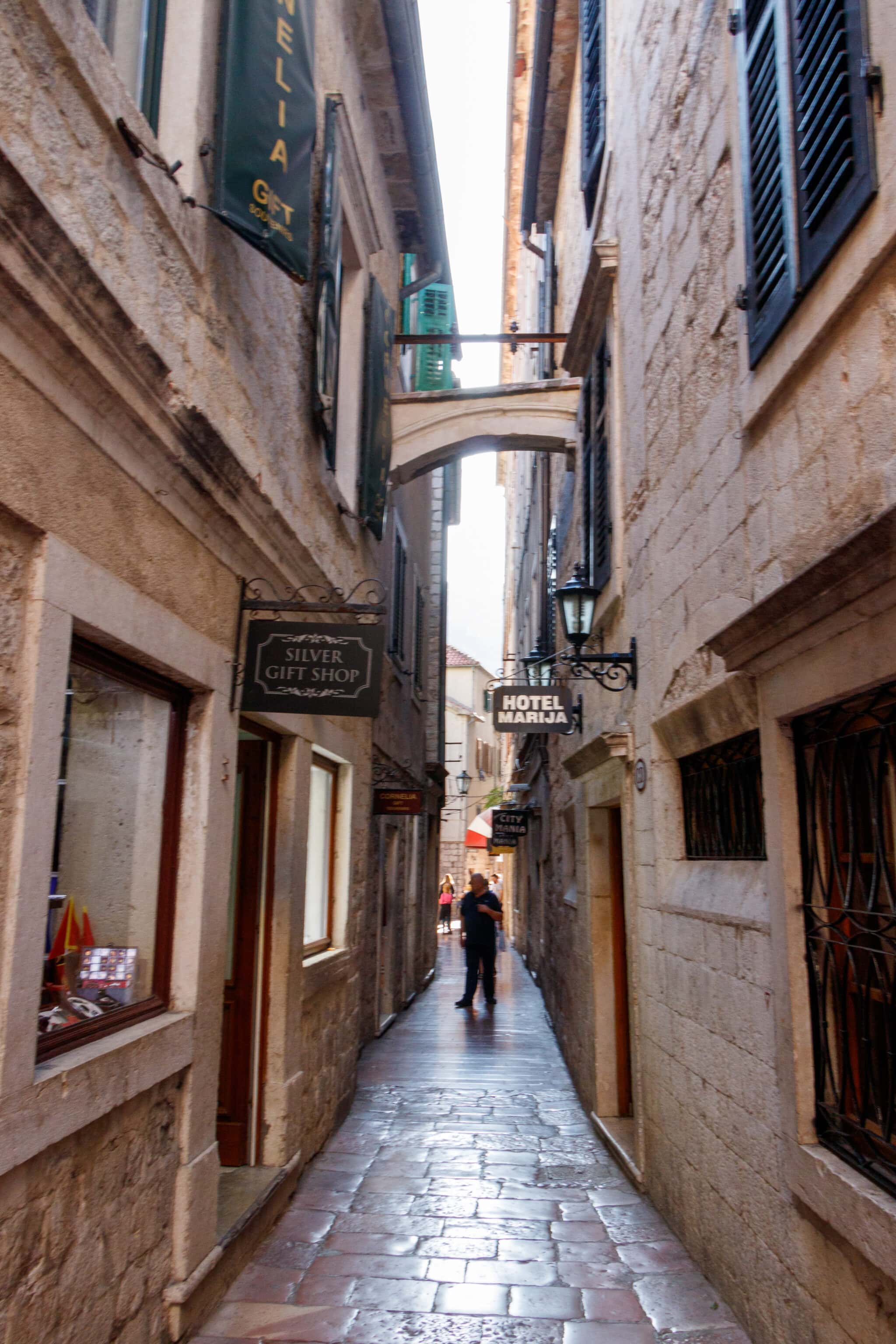
Considering the limited options for swimming in the sea, many are interested in hotels with a pool. But there are no such apartments in Kotor. You need to search for them in the vicinity.
Best area to stay in Kotor, Montenegro
If you are attracted by the atmosphere of medieval apartments, then you can stay in the Kotor Old Town. It will be noisier and a bit more expensive. If you need modern comfort more than ancient interior and exterior, then I advise you to settle outside the walls of the Old Town, in neighboring Dobrota or Skaljari. Or even further – in the village of Donji Orahovac.
You can also consider Muo and Prcanj, located opposite Kotor and Dobrota, on the other side of the Bay of Kotor. You can easily walk from Muo to Kotor. Prcanj is a bit further away – it makes sense to consider going there by bus or boat.
Restaurants & Bars
In the Old Town of Kotor there are many restaurants, bars and cafes where you can taste multiple kinds of food. Many of them are with open terraces. During the season, you can meet them literally at every step.
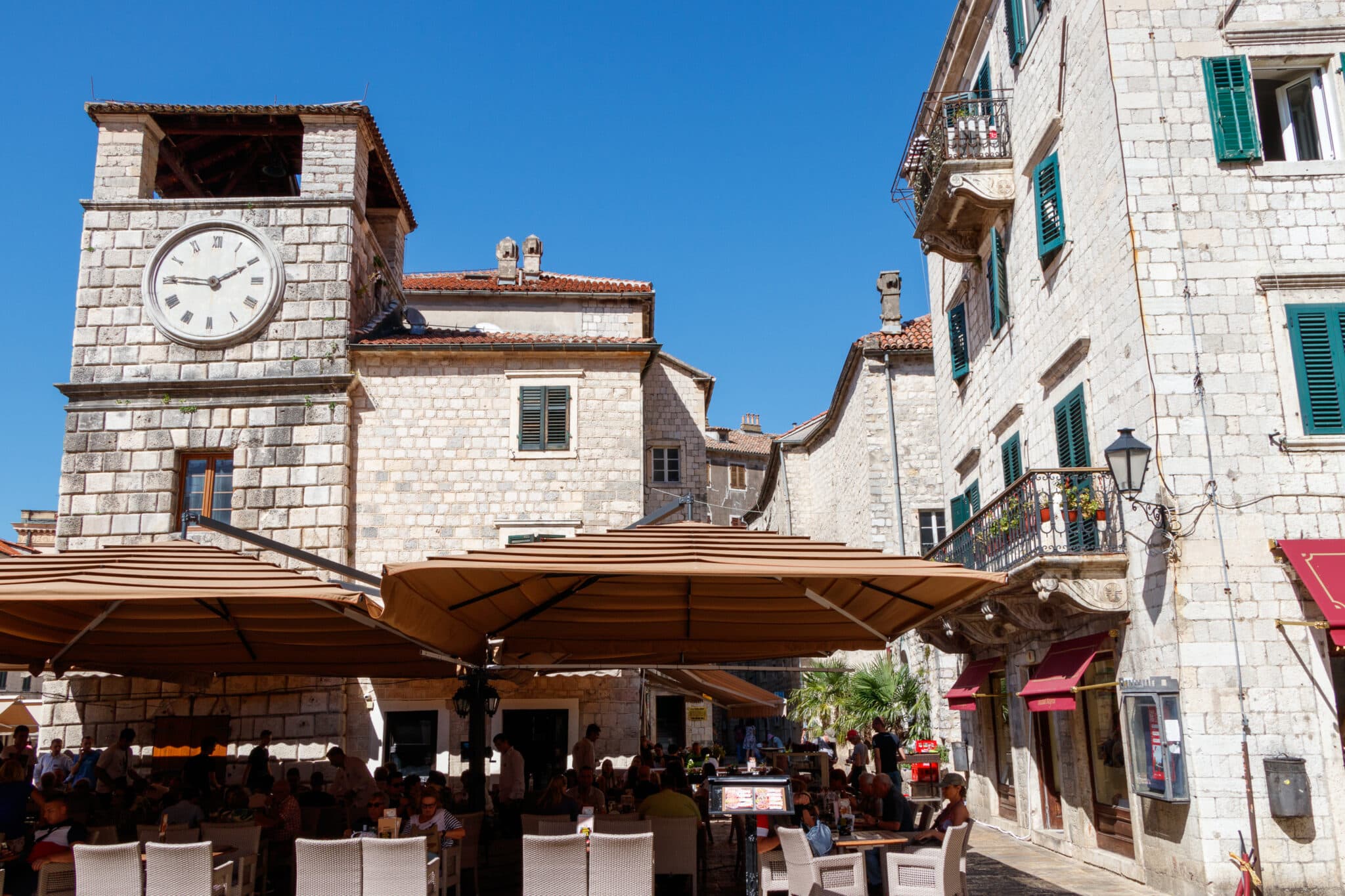
All the restaurants are located in historic buildings. As a result, many of them have unique interiors and decorations. On average, prices in restaurants in the Old Town are noticeably higher than outside it.
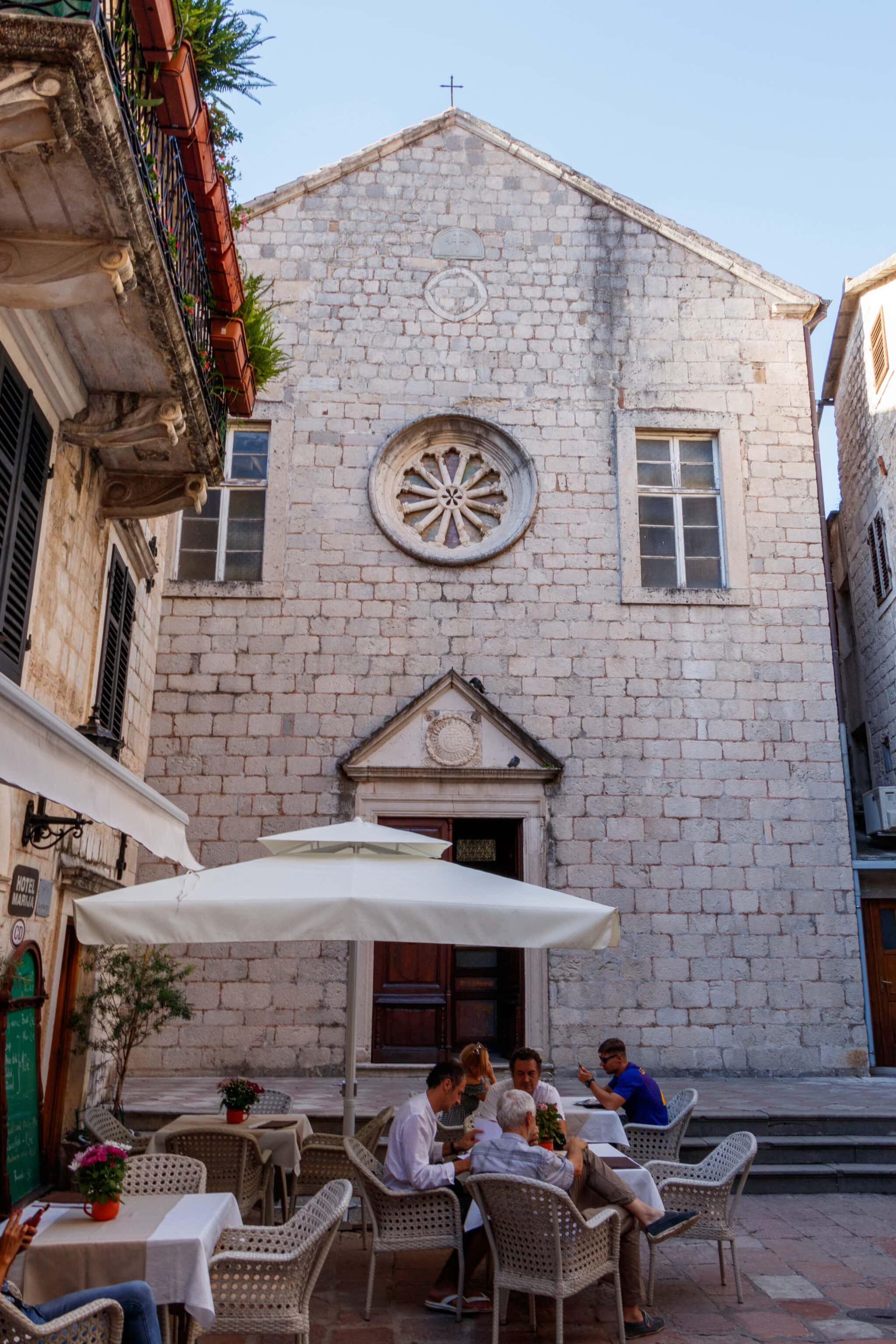
Outside the walls of the Old Town, there are also many bars and restaurants. Many are located right on the beach, with a beautiful view of the Bay of Kotor. Their prices are lower on average. And the dishes’ quality can be even higher than in the Old Town. At the same time, the interior decoration will not necessarily be ordinary.
If you want to see locations, reviews, menus, etc., in advance, I list the most popular restaurants in Kotor.
Top 10 popular restaurants in Kotor:
- Galion (Galleon) restaurant – Kotor
- Astoria restaurant – Old town
- City restaurant – Old town
- Tanjga restaurant – Kotor
- Cesarica restaurant – Old town
- Cattaro restaurant – Kotor
- Forza Mare restaurant – Dobrota
- Stari Mlini restaurant – Ljuta (after Dobrota)
- Przun restaurant – Old Town
- Konoba Portun – Dobrota
Also, many people are searching for a Citadela restaurant, located directly on the city wall. It has really cool views. But I’d recommend checking its review by visitors before going there.
Transport in Kotor
You can move around Kotor and its surroundings by the following types of transport:
Bus
Blue Line buses run around the city of Kotor and neighboring towns. The main line is Skaljari – Kostanjica. Skaljari is located next to the Kotor bus station. From there, the bus travels along the coast of the Bay of Kotor to Kostanjica, almost reaching the Verige Strait. On the way from Skaljari, the bus passes Kotor Old Town, New Town, Drazin Vrt, Dobrota, Ljuta, Donji Orahovac, Perast, Risan, Strp, Lipci and finishes in Kostanjica. Travel time is approximately 1 hour. The fare depends on the duration of the trip. But usually, it’s €1.5. You pay the bus driver in cash.
The company’s website has a schedule, the relevance of which should always be called into question (because this is Montenegro). The schedule hanging at the bus stop (if there is one) is much more likely to be true.
Hop On Hop Off bus
Hop On Hop Off sightseeing bus is a 2-story red double-decker bus in bright colors. The concept is that you buy a pass for one day and use it unlimited times.
The operating company of Hop On Hop Off buses in Kotor is Kotor Open Tour. The bus route is Kotor-Risan-Perast-Bajova Kula (beach)-Kotor. In 2025, the cost of a 1-day ticket is €25 for adults (from 14 years old), €15 for children (6-14 years old), and free for small children (under 6 years old). Their website states that you get a 7% discount by purchasing the ticket online. Audio guide included. The bus runs every 30 minutes.
Taxi
In Kotor, it is strongly recommended to use a taxi on call and not to take it on the street. It will save you a significant amount of money. In the transport guide in Montenegro I described in detail how to use a local taxi. It is better to call through messengers (Viber, WhatsApp).
Red Taxi is the main taxi service in Kotor (it also works in Tivat, which is convenient). Short phone number for calls – 19719 (in Tivat – 19729). Viber, WhatsApp – +382 (67) 019-719 (in Tivat – +382 (67) 019-729). E-mail: redtaxikotor@gmail.com.
Orahovac Taxi – +382 (67) 853-200 (phone, Viber, WhatsApp). E-mail: info@orahovactaxi.com.
Rent a car
A rented car for moving around Kotor itself and its nearest surroundings is not the best option. Parking is a massive problem in this area. During the season there is a significant traffic jam.
Bicycle rental
In general, Montenegro is not a cycling country. Here people prefer to drive a car. But in the Kotor area I met lonely cyclists several times. Perhaps the reason is the same – the problem with parking.
Exploring the Bay of Kotor by bike is tempting, but only at first glance. Yes, the altitude near the highway along the bay’s perimeter is almost flat. But it is a road with one lane in each direction. There are no bike paths or cycle lanes at all. During the season, traffic is heavy. Local drivers usually have a careful manner of driving. But cyclists on the road are still an unusual phenomenon. Tourists are even less predictable.
So it’s up to you to decide whether it’s worth embarking on exploring the Bay of Kotor on two wheels.
If your decision is positive, here are the bike rental services contacts in Kotor:
- Bajkovic Rental Bike – +382 (69) 404-501.
- Buba Ruba – +382 (67) 439 266.
- Rent Bicycle in Kotor – +382 (68) 621-488.
The cost to hire a bike is €10-15 per day.
Bike Tours
Bike rental companies in Kotor and Dobrota often also provide bike tours along the Bay of Kotor area. For example, on the Bajkovic Rental Bike website, I found a 4-hour Adrenalin downhill bike adventure from the Njegusi Village in the Lovcen National Park to the Bay of Kotor.
Sea transport
Kotor has a cruise port from which different ships depart in many directions in the Bay of Kotor. It should be noted that there are few regular routes. Irregular sea transport is represented by tour boats. It’s a good opportunity to see the Bay of Kotor in one go. However, it can be divided into several separate trips. There are also small speed boats just waiting for customers at the pier. Agreed where to go, agreed on a price – and go.
Walking
Your lower limbs are a great option for getting around Kotor and its main points of interest. Most of them are located compactly. Travel time is only limited by your health. The fare is equal to the price of comfortable shoes. I categorically do not advise you to climb to the Kotor fortress in flip-flops. The best choice is non-slip sneakers.
How to get to Kotor?
If you’re getting to Kotor from afar, then most likely by plane. There is no airport in Kotor, Montenegro itself. But it is nearby, in Tivat. You can also come using two more airports – Podgorica (the capital of Montenegro) and Dubrovnik (Croatia). You can also get to Kotor by bus, ferry or cruise ship.
It is most convenient to get through the Tivat airport. But I should mention that many flights are carried out to this airport during the season. There are very few regular flights to Tivat during the off-season.
Before choosing how to get to Kotor, I advise you to get acquainted with the transport features in Montenegro in more detail. In this country, it is better to know the local nuances in advance.
How to get from Tivat airport to Kotor?
The distance from Tivat airport to Kotor is 8 km. You can get there by bus or taxi. Another common way is the transfer service provided by your hotel or apartment owner. Sometimes apartment’s owner may even pick you up for free. Well, or at least at a non-commercial rate.
By bus
There is no regular bus from Tivat airport to Kotor. Actually, there are no regular buses from the airport itself at all. You need to walk 200 meters to the bus stop Tivat-Kotor. Although, in theory, this stop is “illegal”. But if you actively vote, the bus driver will pick you up. A more prominent stop is the Tivat bus station. But you need to walk 1.5 km to get there. The bus fare is €1.5-2.
By taxi
Everything is simple here. Exit the Tivat airport terminal. There will be many taxi drivers waiting for you at the exit. Official and not. You can also call one of the official taxis – by phone or via messengers (Viber, WhatsApp). The fair fare is €4-6. But they can also ask for €15-20 (mainly, it’s applied to unofficial ones). In this case, you can bargain or approach the official taxi with the brand name on the car.
The main taxi in Tivat is Red Taxi. Short number – 19729. Viber, WhatsApp – +382 (67) 019-729. E-mail: redtaxikotor@gmail.com. Taxi also works in Kotor, but using other numbers listed above in the section dedicated to transport in Kotor.
Transfer by hotel or apartment
Many accommodations in Kotor provide this service. Sometimes it may even be free. Or inexpensive.
Car rental at the airport
You can rent a car from several car rental companies at Tivat Airport. But you need to take into account some local features.
In Montenegro, car rental is mainly carried out by local companies, often small ones. However, well-known brands are also represented.
To travel around Montenegro in general, renting a car is a good idea. But the problem of parking in tourist places in the country is very acute. In Kotor, finding a parking spot is even more complicated than the average on the coast. And it’s clear that you simply won’t drive into the Old Town by car. In addition, the Kotor region is the place of the biggest traffic jams in Montenegro during the high season. So think twice if you really need a car. And if so, when exactly?
How to get from Tivat to Kotor?
The easiest way to get from Tivat to Kotor is by bus. The distance between Tivat and Kotor is 11 km. The bus from Tivat to Kotor runs frequently. There are several carriers and passing routes. The easiest stop to find is the Tivat bus station. Most of the buses stop there. But there are also stops in the city itself. They usually have a timetable. The fare is €2-4.
A taxi from Tivat to Kotor costs about €6-8. It can be called or found at one of the parking lots in Tivat. You can often just meet a free-standing taxi in the city.
How to get from Podgorica Airport to Kotor?
Kotor is located 90 km from Podgorica Airport. You can get to Kotor from the capital’s airport by bus or taxi.
Bus
There is no direct bus from Podgorica Airport to Kotor. First, you must get from the airport to the Podgorica bus station. Distance – 11 km. There is no shuttle bus from the airport to Podgorica. The only way to get to the city is by taxi. The price starts at around €15.
From the Podgorica bus station there are direct buses to Kotor. Ticket costs €7-8,5. Travel time is 2-3 hours.
Taxi
From Podgorica Airport to Kotor you can go directly by taxi. The cost of such a trip will start approximately from €60-70. Travel time – 1.5 hours.
Transfer
To avoid calling a taxi at the airport, you can order a transfer from Podgorica airport to Kotor in advance. And it makes sense to do it in certain cases. For example, when your scheduled flight arrives late. And maybe even linger. Trust my experience exactly with Podgorica Airport :)
You can use the online transfer service that you prefer. The route is popular. Most likely, there will be proposals from many services.
In addition, you can order the transfer in advance in the same official taxi services. The pricing policy, in this case, is approximately the following. If a taxi on call on the spot costs from €55, then with a transfer order in advance it will be from €65.
Car rental
Another option to get from Podgorica airport to Kotor is to rent a car at the airport. The situation with car rental companies is similar to Tivat airport.
How to get from Dubrovnik to Kotor?
The distance from Dubrovnik (Croatia) to Kotor is 92 km. You can get there by bus, taxi or ferry.
Bus from Dubrovnik to Kotor
The bus from Dubrovnik to Kotor departs from the Dubrovnik bus station, which is combined with the passenger port. Travel time – 2-2.5 hours. The fare in 2025 is €24-32.
Taxi/Transfer
Taxi from Dubrovnik to Kotor is not actually presented in its classic form. Basically, you need to book a transfer. In dedicated transfer or taxi operators. Travel time is approximately 2 hours. The cost of a transfer from Dubrovnik to Kotor is from €180.
Ferry
In 2025, the Dubrovnik-Kotor ferry has returned to the schedule. It will operate from June 6 to September 30, on Mondays and Wednesdays. Travel time – 3 hours.
Ticket prices for adults:
- One way: €50.00.
- Day trip: €59.00.
For children (ages 3–11.99 years):
- One way: €25.00.
- Round trip: €29.50.
No, I’m not joking. That’s exactly how it’s written on the website – 11.99 years. That’s approximately 11 years and 362 days. So pay close attention :)
How to get from Dubrovnik Airport to Kotor?
Dubrovnik Airport is much closer to Montenegro’s border than the city itself. The distance between Dubrovnik Airport (“Cilipi”) and Kotor is 71 km. But as of 2025, it’s more difficult to get to Montenegro by bus from the airport than from the city.
Bus
For reasons unknown to me, there is not only a direct bus from Dubrovnik airport to Montenegro. But there is not even a bus stop next to it where you could take the same bus that departs from the Dubrovnik bus station. Although the Adriatic Highway (Jadranska Magistrala), along which the bus runs, is laid right at the entrance to the airport.
Overall, the situation is absurd. But such as it is. To get by bus from Dubrovnik airport to Kotor, you first need to take a shuttle bus from the airport to the Dubrovnik bus station. And already there take the bus to Kotor. The cost of a shuttle bus from the airport to the bus station is from €9.
Taxi from Dubrovnik airport to Kotor
The cost of a taxi or transfer from Dubrovnik airport to Kotor starts from €150. Travel time is approximately 1.5 hours.
How to get from Budva to Kotor?
The distance between Budva and Kotor is 23 km. The bus ride takes 30-50 minutes. The fare is €3-5.
The cost of a taxi from Budva to Kotor is from €20.
How to get from Herceg Novi to Kotor?
The distance between Herceg Novi and Kotor is 43 km. It’s by land, strictly along the coast of the Bay of Kotor. The distance can be cut a little by using the Kamenari-Lepetane ferry across the Verige Strait:
But most buses from Herceg Novi to Kotor do not use the ferry. At the same time, many from Herceg Novi to Budva, through Tivat, cross the Verige Strait by ferry.
Bus
The bus ride from Kotor to Herceg Novi takes about 1 hour. The fare is €3-5.
Taxi
The cost of a taxi from Herceg Novi to Kotor is from €40.
How to get from Kotor to Perast?
Let me remind you that Perast is a small historic town on the shores of the Bay of Kotor. One of the must-see attractions in this area.
The distance between Perast and Kotor is 13 km. By water a bit less. You can get there by bus, taxi or sea transport.
Bus from Kotor to Perast
There is no dedicated direct bus from Kotor to Perast. To get to Perast, you need to take a passing bus. And for this trip, as well as for the return from Perast, you need to be information-savvy in advance.
Intercity bus
There are two types of buses to get to Perast. The first option is an intercity bus. There are many of those. Any going to Herceg Novi suits you. It is best to take such a bus at the Kotor bus station.
Then the “perastic” nuances come into play. Perast is a tiny town. There is no bus station. Moreover, intercity buses don’t enter the town itself. They pass “above” it, along the Adriatic highway.
You need to warn the driver or conductor shortly before Perast that you need to get off in Perast. The stop is not marked. In my case, it turned out that only I had to get out in Perast. So don’t rely on someone else to do the job for you. Hop off and go down to the city.
Accordingly, to return from Perast to Kotor, you will need to stop the intercity bus. In a place where the stop is not marked in any way. And the approximate schedule can only be viewed online.
I did not engage in this quest and left for Kotor on a local bus by a lower road in Perast itself.
Local bus
The second option is the local bus of the Blue Line company, running on the route Skaljari – Kostanjica. Skaljari is in the direction of Kotor, Kostanjica is in the direction of Herceg Novi.
This bus stops at every stop in Kotor and further along the route. It is the only one that goes directly into Perast. There are three stops in the town – at the entrance, exit and in the center. You can exit at any. The city is small. It doesn’t matter where you start discovering it.
Leaving Perast on a local bus is much easier than on an intercity. Stops in both directions in the center are in one place – one opposite the other. The bus stop “pavilion” is located on the side in the direction of Kotor. Here it is:
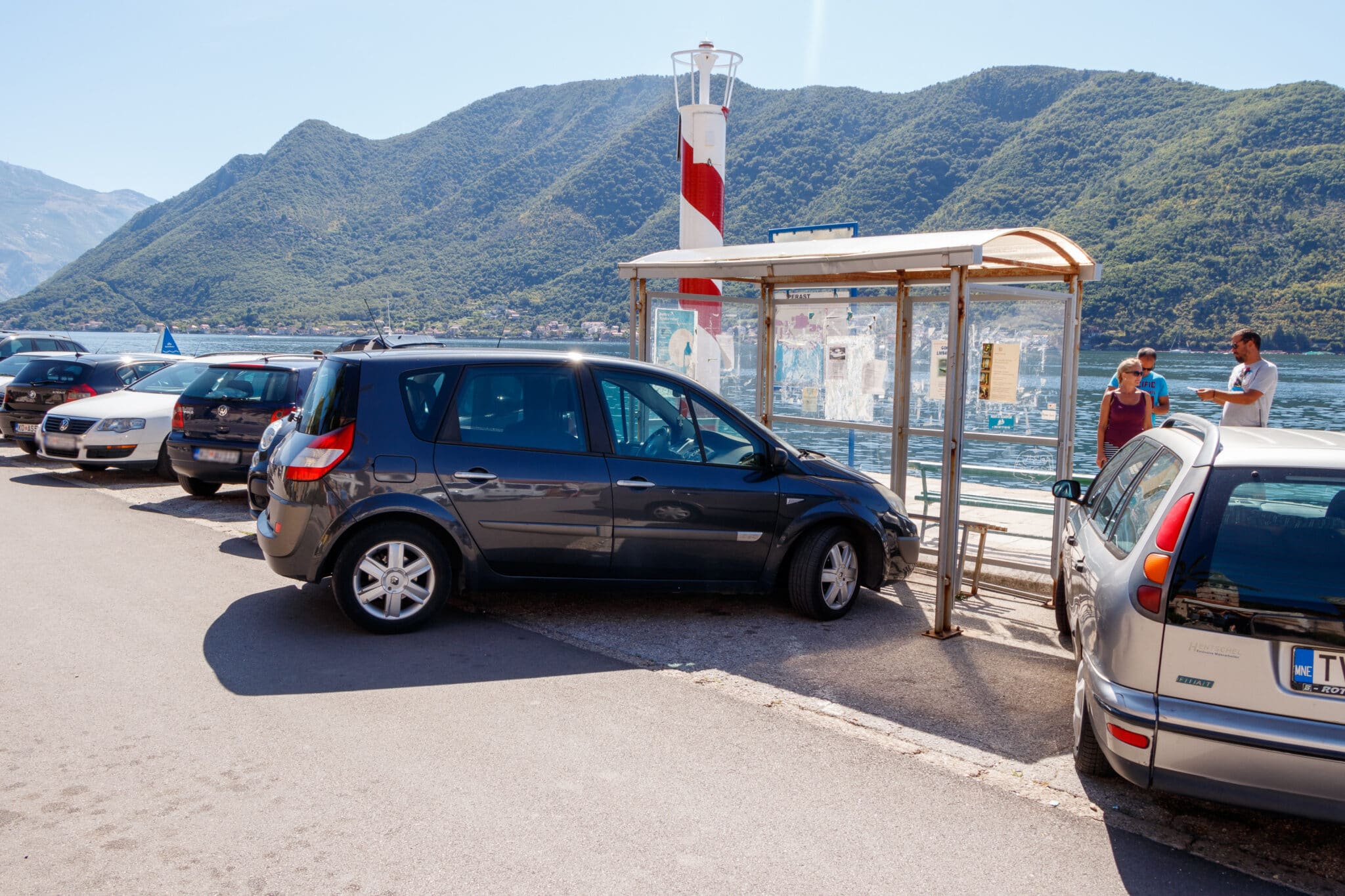
During the season, buses run approximately every hour. But when exactly the next one will come is nearly impossible to know because there is no timetable. Just sit somewhere nearby and wait.
For example, I’ve been unlucky in waiting for almost an hour in the scorching Montenegrin sun. I was already turning towards the Bay of Kotor, admiring the views. And the bus came quietly. A couple more moments of admiring the scenery, and I would have to wait another hour for the next bus. But some unknown force made me turn around and see the long-awaited vehicle.
The fare depends on where you are going. From Perast to Kotor they charged me €1.5. You pay the driver in cash.
Hop On Hop Off Tour Bus
To get from Kotor to Perast you can take the Hop On Hop Off Bus. Described this option in the section about transport in Kotor. So here I’d just like to add one obvious thing. It makes sense to use a Hop On Hop Off bus for a trip to Kotor if you plan to visit other attractions along the route of this bus.
Taxi
The cost of a taxi from Kotor to Perast is from €8. The price for a return ride can be higher. It’s because there is no dedicated taxi rank in Perast. There is a small chance that someone will be waiting for clients in the parking lot at the entrance to the city. But, as a rule, it is unprofitable for taxi drivers to do this. After transporting passengers to Perast, it is more interesting for them to return to Kotor and take several orders there than to wait for one ride from Perast.
And if you call a taxi that will go for you from Kotor, then the price will probably be higher than the one you came to Perast.
How to get from Kotor to Zabljak?
The city of Zabljak in northern Montenegro is the administrative center of the Durmitor National Park. These beautiful places are extremely popular among tourists.
But keep in mind that they are pretty far from the coast. The distance between Kotor and Zabljak is 164 km along a shorter mountain road through Niksic. Or 202 km along the more popular road along the coast, through Budva, Cetinje and Podgorica.
Bus
There is direct bus from Kotor to Zabljak (launched in 2024). Or you can use two buses – Kotor-Podgorica and Podgorica-Zabljak.
Direct bus goes once a day. The ride takes 3,5h. The price is €20. The bus from Kotor to Podgorica takes 2-2.5 hours. The ticket costs €7-8,5. The duration of the bus trip from Podgorica to Zabljak is 2.5-3 hours. The fare is €10-11,5.
Rent a car
In the case of a trip from Kotor to Zabljak/Durmitor, renting a car would be a good idea. Unless, of course, you feel confident enough driving in the mountains. Exploring Durmitor by public transport will not work. It’s only by car, bicycle and on foot. So you will pay either only for a vehicle or for a car with a driver. Or you won’t see everything. But on the other hand, you’ll have a lot of hiking experience, like me :)
Kotor to Zabljak drive time is 2.5-3h.
With a tour
Many excursions are taken to Durmitor during the season. On the one hand, this is convenient. On the other hand, you won’t see a lot with a standard 1-day group tour. It is better to take an individual one. It will cost more but will allow you to see more in a more sparing mode and comfortable environment.
How to get from Kotor to Cavtat (Croatia)?
The city of Cavtat is located in Croatia, near the Dubrovnik airport. It’s a small, lovely historic town in a bay on the Adriatic Sea. If you have free time, I recommend visiting it.
The distance from Kotor to Cavtat is 76 km. But if you go from Kotor to Cavtat by a regular bus, you will have to go to Dubrovnik first. And from there by bus or boat to Cavtat.
Bus from Dubrovnik to Cavtat
The local bus goes from Dubrovnik to Cavtat from the bus station and stops at the bus stops in the city.
Boat
A small boat goes from Dubrovnik to Cavtat from the Dubrovnik Old Town port pier. Travel time – 1h 15 min. The ticket price is from €10. The views are more beautiful than during the trip by bus.
How to get from Kotor to Split (Croatia)?
The distance between Kotor and Split is 322 km. It’s far. There is no direct transport connection – bus, flight or ferry. The standard way to get from Kotor to Split is via Dubrovnik.
You can get from Dubrovnik to Split in two main ways – by bus and ferry. The bus goes 4-4.5 hours. And crosses the border with Bosnia and Herzegovina twice. Ticket price – €14-25.
In 2025, the Dubrovnik-Split ferry by Jadrolinija has returned to the schedule.
Kotor vicinities
Don’t want to stay in the overcrowded Kotor itself? Or want to save money? Do you need a beach where you can not only sunbathe but also swim? Then it makes sense to consider accommodation options in locations near Kotor.
Dobrota
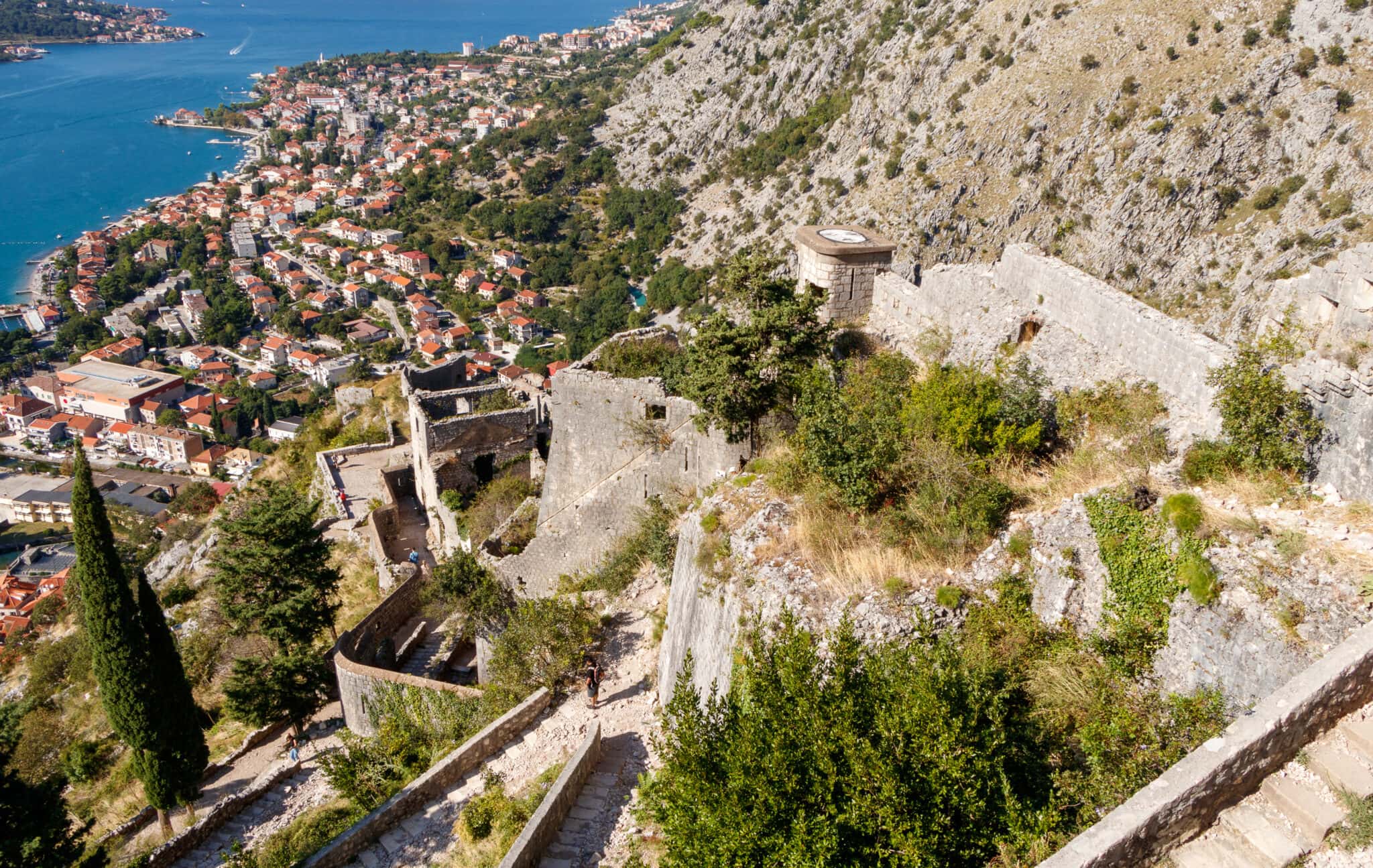
The city of Dobrota is the closest neighbor of Kotor. In fact, one city smoothly flows into another. Dobrota is stretched along the coast of the Bay of Kotor. The population is about 8000.
Dobrota also has a rich history, although not like its neighbor. The architecture mainly belongs to the Venetian era. There are no really significant objects here. But the city itself is quite nice, with beautiful views from the waterfront.
Attractions
Dobrota’s attractions are mainly represented by several churches and palaces (not very impressive):
- Church of St. Eustache. Quite beautiful from the outside, with rich interior decoration. It is located on the northern outskirts of Dobrota, quite far from Kotor.
- Church of St. Matthew. It is located relatively close to Kotor.
- Church of Elijah the Prophet.
- Milosevic Palace. Used as a museum.
- Tripkovic Palace. Used as a museum and restaurant.
- Radimir-Dabinovic Palace.
- Dabinovic Palace. Used as the remains of a palace.
Beaches
There are several beaches in Dobrota. All of them are narrow, with a large or small pebble. There are platforms. You can swim on the Dobrota beaches in the northern part of the city. The water is cleaner there.
Hotels and apartments
The part of Dobrota, which is closer to Kotor, is an alternative to accommodation in Kotor itself. In case you want to stay overnight in modern hotels or apartments, rather than in the historic buildings of the Old Town.
The top 10 popular hotels and apartments in Dobrota have already been listed above.
Donji Orahovac
Donji Orahovac, or simply Orahovac, is a small village on the shore of the Bay of Kotor. A little north of Dobrota. A place for a very relaxing holiday. The beaches here are good, and the water is one of the cleanest in the entire Bay of Kotor. There are no attractions.
Prcanj
From the lower and upper parts of Kotor you will have beautiful views of the opposite peninsula and the villages on its coast. Those that are further away, on several capes, are the town of Prcanj. It’s located just opposite Dobrota. Like many other neighbors in the Bay of Kotor, it has a rich history. And also reached its heyday in the period of the Venetian Republic.
The Prcanj sailors were highly valued in Venice. For one extremely useful feature. Their ships were the fastest. Faster than Michael Phelps at his best. Therefore, in the Venetian Republic, they were used as postal.
Prcanj is a place for a relaxing holiday. On the one hand – it’s literally opposite one of the main tourist cities of Montenegro – Kotor. On the other hand, it is a bit aside, around the corner, where there are no crowds of tourists.
Attractions
The main historical architecture of Prcanj dates back to the Venetian period. There are few attractions here. The city is attractive as a whole. The main attraction of Prcanj is the Church of the Nativity of the Blessed Virgin Mary. As for such a small town as Prcanj, the size of the temple is impressive.
There are also a couple of palaces. As is often the case in these lands, the palaces are quite small. And time has spared not all of them.
Also, Prcanj has a nice promenade with historical buildings, cafes and restaurants.
Beaches
Most of the beaches in Prcanj are platforms with stairs leading into the water. In some places there are narrow pebble beaches. The depth starts almost immediately.
How to get to Prcanj?
Prcanj is located a bit away from the most crowded places. The Adriatic Highway, which encircles almost the entire Bay of Kotor, passes through it. However, with the opening of the Kamenari-Lepetane ferry across the Verige Strait, the Prcanj’s section of the highway has become much less busy. The most convenient way to get to Prcanj is by bus from Kotor.
FAQ
Kotor, Montenegro is a trendy destination. Tourists are searching for answers to many questions about this town. Some of them are really strange. I’ve selected the most frequently asked questions about Kotor. The answers are below.
What country is Kotor, Montenegro in?
Kotor is in Montenegro. Montenegro has been an independent country since 2006. Your geography teacher can prove it.
What language is spoken in Kotor, Montenegro?
Locals speak in Montenegrin or Serbian. These languages are pretty similar. In Kotor many people involved in tourism also can speak English. It differs Kotor positively from all other touristic destinations in Montenegro.
What currency is used in Kotor, Montenegro?
In Kotor they use the euro. Like in all the Montenegro. At the same time, Montenegro doesn’t belong to the eurozone and is not an EU member.
What time is it in Kotor, Montenegro?
The time in Kotor is CET (Central European Time). UTC+01:00.
Can you swim in Kotor?
Yes, you can swim in Kotor. There is a beach near the entrance to the Kotor Old Town and cruise port. But I wouldn’t recommend you to swim there because the water is not clean by any means.
Where to swim in Kotor?
You can find better beaches in neighboring towns – Dobrota, Orahovac and Prcanj. To swim on a perfect beach, you must go to the Adriatic coast – to Zanjice or Plavi Horizonti (Blue Horizons) beaches.
How deep is the Bay of Kotor?
The maximum depth of the Bay of Kotor varies from 20m to 60m. In different parts of the bay.
How long to stay in Kotor?
The minimum time to stay in Kotor is 2 days. 5 days will be more than enough. Just my subjective opinion.
Where do cruise ships dock in Kotor?
There is one 300-meter pier for cruise ships in Kotor. It’s located just in front of the entrance to the Old Town. So you won’t need to search for where to go after going ashore.
How expensive is Kotor?
Kotor is slightly more expensive than most resorts on the Montenegro coast. But it’s much cheaper than the more famous neighboring competitor – Dubrovnik in Croatia. They say that on average you’ll need around €80 per day in Kotor.
How high is the Kotor fortress?
St. John’s Kotor fortress is 260m high above the city of Kotor. The ladder to this fortress is pretty long and steep.
How many steps to Kotor fortress?
The stone ladder to the Kotor fortress has 1350 steps. Want to check? Believe me, counting will become your last concern very shortly after starting climbing.
How long does it take to climb Kotor fortress?
The average time to climb to the Kotor fortress is around 1h. It’s based on my experience. I spent 50 minutes. But it was in a hurry. If you want to do it very slowly – your climbing time will be around 1,5 minutes. The record climbing time is 32 minutes and 24 seconds. The records man is a cruise ship passenger who found on the pier that he dropped his passport at fortress shortly before the ship’s departure.
Conclusion
The city of Kotor is one of the places in Montenegro that I definitely recommend visiting. Moreover, there are many interesting things not only in the town itself and within walking distance from it. It is convenient to go from Kotor to other attractions in the Bay of Kotor, to Lovcen National Park, or Croatian Dubrovnik and Cavtat.
I do not recommend visiting Kotor as part of a big group Montenegro tour. Even a 1-day group tour to Kotor, for my taste, is a “so-so” option. It’s better to allocate enough time to explore these places in a relaxed mode.
It’s not necessary to settle in Kotor itself. It’s convenient to get to from nearby major Montenegro resorts on the coast. But you can also stay in the city itself, both in the historical buildings of the Old Town and in more comfortable modern hotels.
Montenegro has many other exciting places besides those mentioned in this guide. You can find more helpful information about this country in my ultimate guide to Montenegro and other guides on my blog.
All videos from Montenegro are on my Youtube channel – Travirta.
Hello,
So you know if the Bella Boka boats will be available in August 2023 between Tivat and Herceg Novi?
Thanks,
Colin
UK
Hi Colin,
Not sure about this. It’s Montenegro :) No signs that their website or Social Media have been updated recently.
I think the most reliable source of info here is the company itself :) You can try to reach them by following contacts:
info@bellaboka.me
+382 67 000 033
+382 69 540 771
Also, I’d recommend you check their fresh Google reviews in June. Based on this source, passengers had some problems using their services last year. But there is one good review left two weeks ago. So, fingers crossed :)
And there is a chance that I’ll check it on-site until August and will let you know :)
Anyway, there are multiple options to get from Tivat to Herceg Novi. Including the Kamenari-Lepetane ferry, and further by bus. Or by bus to Kotor and from Kotor to Herceg Novi. Have a good time in Montenegro!